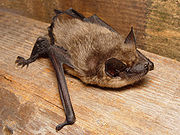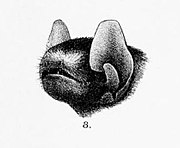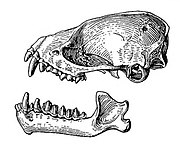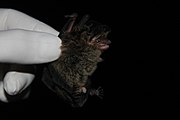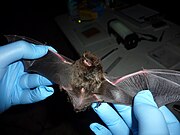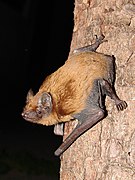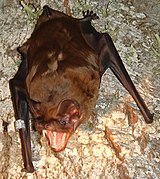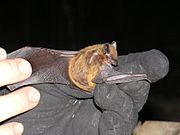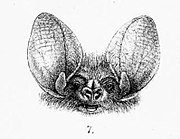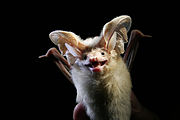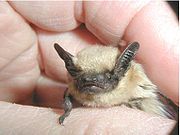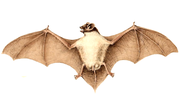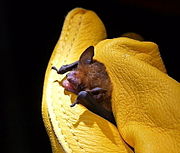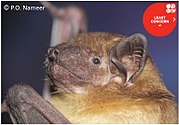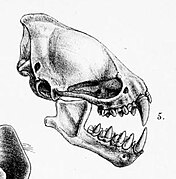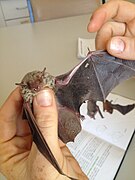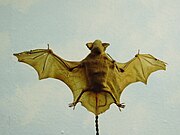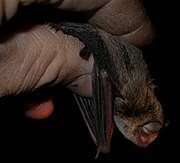List of vespertilionines

Vespertilioninae is one of the four subfamilies of Vespertilionidae, itself one of twenty families of bats in the mammalian order Chiroptera and part of the microbat suborder. A member of this subfamily is called a vespertilionine, or a vesper bat. They are found in all continents besides Antarctica, primarily in caves, forests, and rocky areas, though some species can also be found in shrublands, grasslands, or deserts. They range in size from the pygmy bamboo bat, at 2 cm (1 in) plus a 2 cm (1 in) tail, to the Schreber's yellow bat, at 13 cm (5 in) plus a 10 cm (4 in) tail. Like all bats, vespertilionines are capable of true and sustained flight, and have wing lengths ranging from 2 cm (1 in) to 7 cm (3 in). They are all insectivorous and eat a variety of insects and spiders, with the exception of the greater noctule bat, which regularly eats small birds.[1][2] Almost no vespertilionines have population estimates, though seven species—the New Caledonian wattled bat, Guadeloupe big brown bat, Socotran pipistrelle, Rosevear's serotine, Japanese noctule, Madeira pipistrelle, and Genoways's yellow bat—are categorized as endangered species, and five species—the New Zealand long-tailed bat, New Caledonian long-eared bat, New Guinea big-eared bat, Canary long-eared bat, and Sardinian long-eared bat—are categorized as critically endangered with populations as low as 40. Three species—the Lord Howe long-eared bat, Christmas Island pipistrelle, and Sturdee's pipistrelle—have been made extinct since 1500 CE.
The 275 extant species of Vespertilioninae are divided between 45 genera, ranging in size from 1 to 33 species. A few extinct prehistoric vespertilionine species have been discovered, though due to ongoing research and discoveries the exact number and categorization is not fixed.[3]
Conventions
[edit]| Conservation status | |
|---|---|
| EX | Extinct (3 species) |
| EW | Extinct in the wild (0 species) |
| CR | Critically Endangered (5 species) |
| EN | Endangered (7 species) |
| VU | Vulnerable (17 species) |
| NT | Near threatened (14 species) |
| LC | Least concern (171 species) |
| Other categories | |
| DD | Data deficient (60 species) |
| NE | Not evaluated (1 species) |
Conservation status codes listed follow the International Union for Conservation of Nature (IUCN) Red List of Threatened Species. Range maps are provided wherever possible; if a range map is not available, a description of the vespertilionine's range is provided. Ranges are based on the IUCN Red List for that species unless otherwise noted. All extinct species or subspecies listed alongside extant species went extinct after 1500 CE, and are indicated by a dagger symbol "†". Population figures are rounded to the nearest hundred.
Classification
[edit]Vespertilioninae, one of the four subfamilies of the family Vespertilionidae, contains 275 extant species divided into 45 genera, plus 3 species that have been made extinct in the modern era.
Subfamily Vespertilioninae
- Genus Antrozous (pallid bat): one species
- Genus Arielulus (gilded sprites): four species
- Genus Baeodon (yellow bats): two species
- Genus Barbastella (barbastelles): four species
- Genus Bauerus (Van Gelder's bat): one species
- Genus Chalinolobus (wattled bats): seven species
- Genus Corynorhinus (American lump-nosed bats): three species
- Genus Eptesicus (serotine bats): twenty-six species
- Genus Euderma (spotted bat): one species
- Genus Falsistrellus (false pipistrelles): two species
- Genus Glauconycteris (butterfly bats): twelve species
- Genus Glischropus (thick-thumbed bats): three species
- Genus Hesperoptenus (false serotines): five species
- Genus Histiotus (big-eared brown bats): seven species
- Genus Hypsugo (Asian pipistrelles): eighteen species
- Genus Ia (great evening bat): one species
- Genus Idionycteris (Allen's big-eared bat): one species
- Genus Laephotis (African long-eared bats): four species
- Genus Lasionycteris (silver-haired bat): one species
- Genus Lasiurus (red bats): seventeen species
- Genus Mimetillus (Moloney's mimic bat): one species
- Genus Neoromicia (serotines): sixteen species
- Genus Nyctalus (noctule bats): eight species
- Genus Nycticeinops (serotines): one species
- Genus Nycticeius (evening bats): three species
- Genus Nyctophilus (Australian big-eared bats): seventeen species (one extinct)
- Genus Otonycteris (long-eared bats): two species
- Genus Parastrellus (canyon bat): one species
- Genus Perimyotis (tricolored bat): one species
- Genus Pharotis (New Guinea big-eared bat): one species
- Genus Philetor (Rohu's bat): one species
- Genus Pipistrellus (pipistrelles): thirty-three species (two extinct)
- Genus Plecotus (lump-nosed bats): sixteen species
- Genus Rhogeessa (yellow bats): eleven species
- Genus Rhyneptesicus (Sind bat): one species
- Genus Scoteanax (Rüppell's broad-nosed bat): one species
- Genus Scotoecus (lesser house bats): five species
- Genus Scotomanes (harlequin bat): one species
- Genus Scotophilus (Old World yellow bats): eighteen species
- Genus Scotorepens (broad-nosed bats): four species
- Genus Scotozous (Dormer's bat): one species
- Genus Thainycteris (Collared sprite): one species
- Genus Tylonycteris (bamboo bats): three species
- Genus Vespadelus (forest bats): nine species
- Genus Vespertilio (parti-coloured bats): two species
Vespertilionines
[edit]The following classification is based on the taxonomy described by the reference work Mammal Species of the World (2005), with augmentation by generally accepted proposals made since using molecular phylogenetic analysis, as supported by both the IUCN and the American Society of Mammalogists.[4]
| Common name | Scientific name and subspecies | Range | Size and ecology | IUCN status and estimated population |
|---|---|---|---|---|
| Pallid bat | A. pallidus (LeConte, 1856) |
Western North America and Cuba
|
Size: 5–9 cm (2–4 in), plus 3–6 cm (1–2 in) tail 3–5 cm (1–2 in) arm/wing length[5] Habitat: Forest, rocky areas, and caves[6] |
LC
|
| Common name | Scientific name and subspecies | Range | Size and ecology | IUCN status and estimated population |
|---|---|---|---|---|
| Bronze sprite | A. circumdatus (Temminck, 1840) |
Southeastern Asia
|
Size: 4–6 cm (2 in), plus 3–5 cm (1–2 in) tail 3–5 cm (1–2 in) arm/wing length[7] Habitat: Forest[8] |
LC
|
| Coppery sprite
|
A. cuprosus Hill & Francis, 1984 |
Malaysia
|
Size: About 6 cm (2 in), plus 3–5 cm (1–2 in) tail 3–4 cm (1–2 in) arm/wing length[7] Habitat: Forest[9] |
VU
|
| Necklace sprite
|
A. torquatus (Csorba & Lee, 1999) |
Taiwan
|
Size: 4–7 cm (2–3 in), plus 3–5 cm (1–2 in) tail 4–5 cm (2 in) arm/wing length[7] Habitat: Forest and inland wetlands[10] |
LC
|
| Social sprite
|
A. societatis Hill, 1972 |
Malay Peninsula
|
Size: 4–5 cm (2 in), plus 3–4 cm (1–2 in) tail 3–5 cm (1–2 in) arm/wing length[7] Habitat: Forest[11] |
LC
|
| Common name | Scientific name and subspecies | Range | Size and ecology | IUCN status and estimated population |
|---|---|---|---|---|
| Allen's yellow bat
|
B. alleni Thomas, 1892 |
Southern Mexico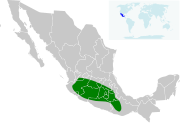
|
Size: 4–5 cm (2 in), plus 3–5 cm (1–2 in) tail 3–4 cm (1–2 in) arm/wing length[5] Habitat: Forest[12] |
LC
|
| Slender yellow bat
|
B. gracilis Miller, 1897 |
Southern Mexico
|
Size: 4–5 cm (2 in), plus 3–5 cm (1–2 in) tail about 3 cm (1 in) arm/wing length[5] Habitat: Forest[13] |
LC
|
| Common name | Scientific name and subspecies | Range | Size and ecology | IUCN status and estimated population |
|---|---|---|---|---|
| Arabian barbastelle | B. leucomelas (Cretzschmar, 1826) |
Egypt and western Asia | Size: About 5 cm (2 in), plus 1–2 cm (0.4–0.8 in) tail 3–5 cm (1–2 in) arm/wing length[5] Habitat: Forest, shrubland, rocky areas, and caves[14] |
LC
|
| Beijing barbastelle
|
B. beijingensis Zhang, Han, Jones, Lin, Zhang, Zhu, Huang, & Zhang, 2007 |
China | Size: 5–6 cm (2 in), plus 3–5 cm (1–2 in) tail 4–5 cm (2 in) arm/wing length[5] Habitat: Forest and caves[15] |
DD
|
| Eastern barbastelle
|
B. darjelingensis (Hodgson, 1855) |
Southern and eastern Asia
|
Size: 4–6 cm (2 in), plus 4–5 cm (2 in) tail 3–5 cm (1–2 in) arm/wing length[5] Habitat: Forest and caves[16] |
LC
|
| Western barbastelle | B. barbastellus (Schreber, 1774) |
Europe, northern Africa, and western Asia
|
Size: 4–6 cm (2 in), plus 3–6 cm (1–2 in) tail 3–5 cm (1–2 in) arm/wing length[5] Habitat: Forest, shrubland, rocky areas, and caves[17] |
NT
|
| Common name | Scientific name and subspecies | Range | Size and ecology | IUCN status and estimated population |
|---|---|---|---|---|
| Van Gelder's bat | B. dubiaquercus Van Gelder, 1959 |
Southern Mexico and Central America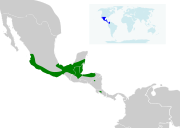
|
Size: 5–8 cm (2–3 in), plus 4–6 cm (2 in) tail 5–6 cm (2 in) arm/wing length[5] Habitat: Forest[18] |
NT
|
| Common name | Scientific name and subspecies | Range | Size and ecology | IUCN status and estimated population |
|---|---|---|---|---|
| Chocolate wattled bat | C. morio (Gray, 1841) |
Australia | Size: 4–7 cm (2–3 in), plus 3–5 cm (1–2 in) tail 3–5 cm (1–2 in) arm/wing length[19] Habitat: Forest, savanna, shrubland, grassland, and caves[20] |
LC
|
| Gould's wattled bat | C. gouldii (G. R. Gray, 1841) |
Australia
|
Size: 4–8 cm (2–3 in), plus 4–5 cm (2 in) tail 3–5 cm (1–2 in) arm/wing length[21] Habitat: Forest, savanna, and shrubland[22] |
LC
|
| Hoary wattled bat
|
C. nigrogriseus Gould, 1852 |
Northern Australia
|
Size: 4–6 cm (2 in), plus 2–5 cm (1–2 in) tail 3–4 cm (1–2 in) arm/wing length[21] Habitat: Forest, savanna, and shrubland[23] |
LC
|
| Large-eared pied bat | C. dwyeri Ryan, 1966 |
Eastern Australia | Size: 4–6 cm (2 in), plus 3–5 cm (1–2 in) tail 3–5 cm (1–2 in) arm/wing length[21] Habitat: Forest, savanna, and caves[24] |
VU
|
| Little pied bat
|
C. picatus Gould, 1852 |
Eastern Australia | Size: 4–5 cm (2 in), plus 2–4 cm (1–2 in) tail 3–4 cm (1–2 in) arm/wing length[21] Habitat: Forest, savanna, and shrubland[25] |
NT
|
| New Caledonian wattled bat
|
C. neocaledonicus Revilliod, 1914 |
New Caledonia | Size: About 5 cm (2 in), plus 3–5 cm (1–2 in) tail 3–4 cm (1–2 in) arm/wing length[21] Habitat: Shrubland[26] |
EN
|
| New Zealand long-tailed bat | C. tuberculatus (Forster, 1844) |
New Zealand | Size: 4–7 cm (2–3 in), plus 3–5 cm (1–2 in) tail 3–5 cm (1–2 in) arm/wing length[19] Habitat: Forest and shrubland[27] |
CR
|
| Common name | Scientific name and subspecies | Range | Size and ecology | IUCN status and estimated population |
|---|---|---|---|---|
| Mexican big-eared bat | C. mexicanus Allen, 1916 |
Mexico
|
Size: 4–6 cm (2 in), plus 4–6 cm (2 in) tail 3–5 cm (1–2 in) arm/wing length[28] Habitat: Forest and caves[29] |
NT
|
| Rafinesque's big-eared bat | C. rafinesquii Lesson, 1827 |
Eastern United States
|
Size: 3–6 cm (1–2 in), plus 4–6 cm (2 in) tail 3–5 cm (1–2 in) arm/wing length[28] Habitat: Forest and caves[30] |
LC
|
| Townsend's big-eared bat | C. townsendii Cooper, 1837 |
Western and eastern Noth America
|
Size: 5–6 cm (2 in), plus 3–6 cm (1–2 in) tail 3–5 cm (1–2 in) arm/wing length[28] Habitat: Caves, shrubland, and forest[31] |
LC
|
| Common name | Scientific name and subspecies | Range | Size and ecology | IUCN status and estimated population |
|---|---|---|---|---|
| Anatolian serotine
|
E. anatolicus Felten, 1971 |
Western Asia and Egypt | Size: 6–8 cm (2–3 in), plus 4–6 cm (2 in) tail 4–5 cm (2 in) arm/wing length[32] Habitat: Forest and shrubland[33] |
LC
|
| Argentine brown bat | E. furinalis d'Orbigny & Gervais, 1847 |
Mexico, Central America, and South America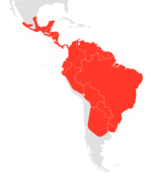
|
Size: 4–7 cm (2–3 in), plus 3–5 cm (1–2 in) tail 3–5 cm (1–2 in) arm/wing length[32] Habitat: Forest[34] |
LC
|
| Big brown bat | E. fuscus (Palisot de Beauvois, 1796) Twelve subspecies
|
North America and northern South America
|
Size: 5–9 cm (2–4 in), plus 3–6 cm (1–2 in) tail 3–6 cm (1–2 in) arm/wing length[32] Habitat: Forest, rocky areas, and caves[35] |
LC
|
| Bobrinski's serotine
|
E. bobrinskoi Kuzyakin, 1935 |
Kazakhstan | Size: 4–7 cm (2–3 in), plus 3–6 cm (1–2 in) tail 3–5 cm (1–2 in) arm/wing length[32] Habitat: Desert[36] |
DD
|
| Botta's serotine
|
E. bottae (Peters, 1869) Seven subspecies
|
Western Asia and Egypt | Size: 5–7 cm (2–3 in), plus 4–6 cm (2 in) tail 3–5 cm (1–2 in) arm/wing length[32] Habitat: Shrubland, rocky areas, and desert[37] |
LC
|
| Brazilian brown bat | E. brasiliensis Desmarest, 1819 Four subspecies
|
Southern Mexico, Central America, and South America
|
Size: 5–7 cm (2–3 in), plus 3–5 cm (1–2 in) tail 3–5 cm (1–2 in) arm/wing length[32] Habitat: Forest[38] |
LC
|
| Chiriquinan serotine
|
E. chiriquinus Thomas, 1920 |
Central America and northern South America
|
Size: 6–7 cm (2–3 in), plus 3–6 cm (1–2 in) tail 4–5 cm (2 in) arm/wing length[32] Habitat: Forest[39] |
LC
|
| Diminutive serotine | E. diminutus Osgood, 1915 Two subspecies
|
Northern and southeastern South America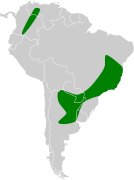
|
Size: About 5 cm (2 in), plus about 4 cm (2 in) tail about 4 cm (2 in) arm/wing length[32] Habitat: Forest[40] |
LC
|
| Gobi big brown bat
|
E. gobiensis Bóbrinski, 1926 Three subspecies
|
Central Asia | Size: 4–7 cm (2–3 in), plus 3–6 cm (1–2 in) tail 3–5 cm (1–2 in) arm/wing length[32] Habitat: Shrubland, grassland, and desert[41] |
LC
|
| Guadeloupe big brown bat
|
E. guadeloupensis Genoways & Baker, 1975 |
Island of Guadeloupe in the Caribbean | Size: 7–8 cm (3 in), plus 5–6 cm (2 in) tail 4–6 cm (2 in) arm/wing length[32] Habitat: Forest[42] |
EN
|
| Harmless serotine
|
E. innoxius (Gervais, 1841) |
Western South America
|
Size: 4–6 cm (2 in), plus 3–5 cm (1–2 in) tail 3–4 cm (1–2 in) arm/wing length[32] Habitat: Forest[43] |
NT
|
| Horn-skinned bat
|
E. floweri De Winton, 1901 |
North-central Africa
|
Size: 4–5 cm (2 in), plus 3–4 cm (1–2 in) tail 3–4 cm (1–2 in) arm/wing length[32] Habitat: Desert, grassland, and shrubland[44] |
LC
|
| Japanese short-tailed bat
|
E. japonensis Imaizumi, 1953 |
Japan | Size: 5–7 cm (2–3 in), plus 3–5 cm (1–2 in) tail 3–5 cm (1–2 in) arm/wing length[5] Habitat: Forest[45] |
VU
|
| Kobayashi's bat
|
E. kobayashii (Mori, 1928) |
Korea
|
Size: 5–7 cm (2–3 in), plus 4–6 cm (2 in) tail 3–5 cm (1–2 in) arm/wing length[32] Habitat: Unknown[46] |
DD
|
| Lagos serotine
|
E. platyops Thomas, 1901 |
Nigeria | Size: 6–8 cm (2–3 in), plus 4–5 cm (2 in) tail 4–6 cm (2 in) arm/wing length[32] Habitat: Unknown[47] |
DD
|
| Little black serotine
|
E. andinus (Allen, 1914) |
Northern and central South America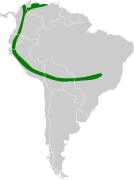
|
Size: 5–7 cm (2–3 in), plus 3–4 cm (1–2 in) tail 3–5 cm (1–2 in) arm/wing length[32] Habitat: Unknown[48] |
LC
|
| Long-tailed house bat
|
E. hottentotus Smith, 1833 Three subspecies
|
Southern Africa | Size: 6–8 cm (2–3 in), plus 3–6 cm (1–2 in) tail 3–6 cm (1–2 in) arm/wing length[32] Habitat: Rocky areas, inland wetlands, grassland, shrubland, savanna, and forest[49] |
LC
|
| Meridional serotine | E. isabellinus Temminck, 1840 |
Northwestern Africa and Spain
|
Size: 6–8 cm (2–3 in), plus 4–6 cm (2 in) tail 4–6 cm (2 in) arm/wing length[32] Habitat: Forest, shrubland, and grassland[50] |
LC
|
| Northern bat | E. nilssonii (Keyserling & Blasius, 1839) Two subspecies
|
Europe and northern Asia
|
Size: 5–7 cm (2–3 in), plus 3–5 cm (1–2 in) tail 3–5 cm (1–2 in) arm/wing length[32] Habitat: Forest, inland wetlands, caves, and desert[51] |
LC
|
| Ognev's serotine
|
E. ognevi Bóbrinski, 1918 |
West-central Asia | Size: 6–7 cm (2–3 in), plus 4–6 cm (2 in) tail 4–5 cm (2 in) arm/wing length[32] Habitat: Shrubland, rocky areas, and desert[52] |
LC
|
| Oriental serotine | E. pachyomus Tomes, 1857 |
Western and Eastern Asia
|
Size: 7–8 cm (3 in), plus 5–6 cm (2 in) tail 4–6 cm (2 in) arm/wing length[32] Habitat: Forest, shrubland, and caves[53] |
LC
|
| Serotine bat | E. serotinus (Schreber, 1774) Ten subspecies
|
Europe and Asia
|
Size: 6–9 cm (2–4 in), plus 3–7 cm (1–3 in) tail 4–6 cm (2 in) arm/wing length[32] Habitat: Forest, savanna, shrubland, grassland, inland wetlands, rocky areas, and caves[54] |
LC
|
| Sombre bat
|
E. tatei Ellerman & Morrison-Scott, 1951 |
India | Size: About 5 cm (2 in), plus about 5 cm (2 in) tail about 4 cm (2 in) arm/wing length[32] Habitat: Forest[55] |
DD
|
| Surat helmeted bat
|
E. dimissus (Thomas, 1916) |
Scattered southeastern Asia
|
Size: 5–7 cm (2–3 in), plus 4–5 cm (2 in) tail 3–5 cm (1–2 in) arm/wing length[21] Habitat: Unknown[56] |
DD
|
| Taddei's serotine | E. taddeii Miranda, Bernardi, & Passos, 2006 |
Southern Brazil | Size: 5–7 cm (2–3 in), plus 4–6 cm (2 in) tail 4–5 cm (2 in) arm/wing length[32] Habitat: Forest[57] |
DD
|
| Thick-eared bat
|
E. pachyotis Dobson, 1871 |
Eastern Asia
|
Size: 5–6 cm (2 in), plus 4–5 cm (2 in) tail 3–5 cm (1–2 in) arm/wing length[5] Habitat: Forest[58] |
LC
|
| Common name | Scientific name and subspecies | Range | Size and ecology | IUCN status and estimated population |
|---|---|---|---|---|
| Spotted bat | E. maculatum (Allen, 1891) |
Western North America
|
Size: 6–7 cm (2–3 in), plus 4–5 cm (2 in) tail 4–6 cm (2 in) arm/wing length[28] Habitat: Forest, caves, and desert[59] |
LC
|
| Common name | Scientific name and subspecies | Range | Size and ecology | IUCN status and estimated population |
|---|---|---|---|---|
| Eastern false pipistrelle
|
F. tasmaniensis (Gould, 1858) |
Eastern Australis | Size: 5–7 cm (2–3 in), plus 4–6 cm (2 in) tail 4–6 cm (2 in) arm/wing length[21] Habitat: Forest[60] |
VU
|
| Western false pipistrelle
|
F. mackenziei Kitchener, Caputi, & Jones, 1986 |
Western Australia | Size: 5–7 cm (2–3 in), plus 4–6 cm (2 in) tail 4–6 cm (2 in) arm/wing length[21] Habitat: Forest[61] |
NT
|
| Common name | Scientific name and subspecies | Range | Size and ecology | IUCN status and estimated population |
|---|---|---|---|---|
| Abo bat | G. poensis (Gray, 1842) |
Western and central Africa | Size: 4–6 cm (2 in), plus 3–5 cm (1–2 in) tail 3–5 cm (1–2 in) arm/wing length[7] Habitat: Forest[62] |
LC
|
| Allen's spotted bat | G. humeralis Allen, 1917 |
Central Africa | Size: 3–5 cm (1–2 in), plus 3–6 cm (1–2 in) tail 3–5 cm (1–2 in) arm/wing length[63] Habitat: Forest[64] |
DD
|
| Allen's striped bat | G. alboguttata Allen, 1917 |
Central Africa | Size: 5–6 cm (2 in), plus 4–5 cm (2 in) tail 3–5 cm (1–2 in) arm/wing length[63] Habitat: Forest[65] |
LC
|
| Beatrix's bat | G. beatrix Thomas, 1901 |
Western and central Africa | Size: 3–5 cm (1–2 in), plus 3–6 cm (1–2 in) tail 3–5 cm (1–2 in) arm/wing length[63] Habitat: Forest[66] |
LC
|
| Bibundi bat
|
G. egeria Thomas, 1913 |
Central Africa | Size: 4–5 cm (2 in), plus 3–5 cm (1–2 in) tail 3–4 cm (1–2 in) arm/wing length[7] Habitat: Forest and unknown[67] |
DD
|
| Curry's bat
|
G. curryae Eger & Schlitter, 2001 |
Central Africa | Size: 4–5 cm (2 in), plus 3–5 cm (1–2 in) tail 3–4 cm (1–2 in) arm/wing length[63] Habitat: Forest[68] |
DD
|
| Glen's wattled bat
|
G. gleni Peterson & Smith, 1973 |
Central Africa | Size: 5–6 cm (2 in), plus 4–5 cm (2 in) tail 3–5 cm (1–2 in) arm/wing length[7] Habitat: Forest[69] |
DD
|
| Kenyan wattled bat
|
G. kenyacola Peterson, 1982 |
Kenya | Size: About 5 cm (2 in), plus about 5 cm (2 in) tail about 4 cm (2 in) arm/wing length[63] Habitat: Unknown[70] |
DD
|
| Machado's butterfly bat
|
G. machadoi Hayman, 1963 |
Angola | Size: About 6 cm (2 in), plus about 5 cm (2 in) tail about 5 cm (2 in) arm/wing length[7] Habitat: Forest[71] |
DD
|
| Pied butterfly bat | G. superba Hayman, 1939 |
Western and central Africa
|
Size: 4–7 cm (2–3 in), plus 3–5 cm (1–2 in) tail 4–5 cm (2 in) arm/wing length[7] Habitat: Forest[72] |
LC
|
| Silvered bat | G. argentata (Dobson, 1875) |
Central Africa | Size: 5–7 cm (2–3 in), plus 4–6 cm (2 in) tail 3–5 cm (1–2 in) arm/wing length[7] Habitat: Forest and savanna[73] |
LC
|
| Variegated butterfly bat | G. variegata (Tomes, 1875) |
Sub-Saharan Africa | Size: 4–7 cm (2–3 in), plus 4–6 cm (2 in) tail 3–5 cm (1–2 in) arm/wing length[7] Habitat: Shrubland, savanna, and forest[74] |
LC
|
| Common name | Scientific name and subspecies | Range | Size and ecology | IUCN status and estimated population |
|---|---|---|---|---|
| Common thick-thumbed bat | G. tylopus (Dobson, 1875) Two subspecies
|
Southeastern Asia
|
Size: About 4 cm (2 in), plus 3–4 cm (1–2 in) tail 2–4 cm (1–2 in) arm/wing length[75] Habitat: Forest[76] |
LC
|
| Indochinese thick-thumbed bat
|
G. bucephalus Csorba, 2011 |
Southeastern Asia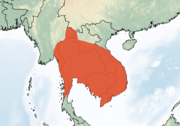
|
Size: 4–5 cm (2 in), plus 3–5 cm (1–2 in) tail 3–4 cm (1–2 in) arm/wing length[75] Habitat: Forest[77] |
LC
|
| Javan thick-thumbed bat
|
G. javanus Chasen, 1939 |
Indonesia | Size: About 4 cm (2 in), plus about 4 cm (2 in) tail about 3 cm (1 in) arm/wing length[75] Habitat: Forest[78] |
DD
|
| Common name | Scientific name and subspecies | Range | Size and ecology | IUCN status and estimated population |
|---|---|---|---|---|
| Blanford's bat
|
H. blanfordi Dobson, 1877 |
Southeastern Asia
|
Size: 3–5 cm (1–2 in), plus 3–4 cm (1–2 in) tail 2–3 cm (1 in) arm/wing length[63] Habitat: Forest and caves[79] |
LC
|
| False serotine bat
|
H. doriae (Peters, 1868) |
Malaysia | Size: About 5 cm (2 in), plus about 4 cm (2 in) tail 3–5 cm (1–2 in) arm/wing length[63] Habitat: Forest[80] |
DD
|
| Gaskell's false serotine
|
H. gaskelli Hill, 1983 |
Indonesia
|
Size: Unknown length about 4 cm (2 in) arm/wing length[63] Habitat: Forest[81] |
DD
|
| Large false serotine
|
H. tomesi Thomas, 1905 |
Southeastern Asia
|
Size: About 7 cm (3 in), plus 4–6 cm (2 in) tail 5–6 cm (2 in) arm/wing length[63] Habitat: Forest[82] |
VU
|
| Tickell's bat | H. tickelli Blyth, 1851 |
Southern and southeastern Asia
|
Size: 6–8 cm (2–3 in), plus 4–7 cm (2–3 in) tail 4–6 cm (2 in) arm/wing length[63] Habitat: Forest and caves[83] |
LC
|
| Common name | Scientific name and subspecies | Range | Size and ecology | IUCN status and estimated population |
|---|---|---|---|---|
| Big-eared brown bat | H. macrotus (Poeppig, 1835) |
Southern South America
|
Size: 5–7 cm (2–3 in), plus 4–7 cm (2–3 in) tail 4–6 cm (2 in) arm/wing length[32] Habitat: Caves[84] |
LC
|
| Humboldt big-eared brown bat
|
H. humboldti Handley, 1996 |
Northern South America
|
Size: 5–6 cm (2 in), plus 4–6 cm (2 in) tail 4–5 cm (2 in) arm/wing length[63] Habitat: Forest[85] |
DD
|
| Small big-eared brown bat | H. montanus Philippi & Landbeck, 1861 |
Western and southern South America
|
Size: 5–7 cm (2–3 in), plus 4–6 cm (2 in) tail 4–6 cm (2 in) arm/wing length[63] Habitat: Forest and caves[86] |
LC
|
| Southern big-eared brown bat | H. magellanicus Philippi, 1866 |
Southern South America
|
Size: 5–7 cm (2–3 in), plus 4–7 cm (2–3 in) tail 4–5 cm (2 in) arm/wing length[63] Habitat: Forest[87] |
LC
|
| Strange big-eared brown bat
|
H. alienus Thomas, 1916 |
Southern South America
|
Size: About 5 cm (2 in), plus about 5 cm (2 in) tail about 5 cm (2 in) arm/wing length[63] Habitat: Unknown[88] |
DD
|
| Thomas's big-eared brown bat | H. laephotis Thomas, 1916 |
Central South America
|
Size: 5–7 cm (2–3 in), plus 4–6 cm (2 in) tail 4–5 cm (2 in) arm/wing length[32] Habitat: Forest[89] |
LC
|
| Tropical big-eared brown bat | H. velatus Geoffroy, 1824 |
Central and western South America
|
Size: 5–8 cm (2–3 in), plus 4–6 cm (2 in) tail 4–5 cm (2 in) arm/wing length[32] Habitat: Forest[90] |
DD
|
| Common name | Scientific name and subspecies | Range | Size and ecology | IUCN status and estimated population |
|---|---|---|---|---|
| Alashanian pipistrelle
|
H. alaschanicus Bóbrinski, 1926 |
Eastern Asia | Size: 3–5 cm (1–2 in), plus 3–4 cm (1–2 in) tail 3–4 cm (1–2 in) arm/wing length[19] Habitat: Forest and caves[91] |
LC
|
| Anthony's pipistrelle
|
H. anthonyi (Tate, 1942) |
Myanmar | Size: About 6 cm (2 in), plus 3–5 cm (1–2 in) tail 3–4 cm (1–2 in) arm/wing length[21] Habitat: Forest[92] |
DD
|
| Arabian pipistrelle
|
H. arabicus Harrison, 1979 |
Southwestern Asia
|
Size: 3–5 cm (1–2 in), plus 3–5 cm (1–2 in) tail 2–4 cm (1–2 in) arm/wing length[19] Habitat: Shrubland, inland wetlands, and desert[93] |
DD
|
| Big-eared pipistrelle | H. macrotis (Temminck, 1840) |
Southeastern Asia
|
Size: About 5 cm (2 in), plus about 4 cm (2 in) tail 3–4 cm (1–2 in) arm/wing length[94] Habitat: Forest and inland wetlands[95] |
DD
|
| Broad-headed serotine
|
H. crassulus (Thomas, 1904) |
Western and central Africa | Size: 4–5 cm (2 in), plus 2–4 cm (1–2 in) tail 2–4 cm (1–2 in) arm/wing length[94] Habitat: Forest[96] |
LC
|
| Brown pipistrelle | H. imbricatus (Horsfield, 1824) |
Southeastern Asia | Size: 4–5 cm (2 in), plus 3–5 cm (1–2 in) tail 3–4 cm (1–2 in) arm/wing length[94] Habitat: Forest and inland wetlands[97] |
LC
|
| Burma pipistrelle
|
H. lophurus (Thomas, 1915) |
Myanmar
|
Size: About 6 cm (2 in), plus about 4 cm (2 in) tail about 4 cm (2 in) arm/wing length[94] Habitat: Forest and grassland[98] |
DD
|
| Cadorna's pipistrelle
|
H. cadornae (Thomas, 1916) |
Southeastern Asia
|
Size: 4–6 cm (2 in), plus 3–5 cm (1–2 in) tail 3–4 cm (1–2 in) arm/wing length[94] Habitat: Forest and caves[99] |
LC
|
| Chinese pipistrelle
|
H. pulveratus (Peters, 1870) |
Eastern and southeastern Asia
|
Size: 3–5 cm (1–2 in), plus 3–4 cm (1–2 in) tail 3–4 cm (1–2 in) arm/wing length[94] Habitat: Forest, rocky areas, and caves[100] |
LC
|
| Chocolate pipistrelle
|
H. affinis Dobson, 1871 |
Southern and southeastern Asia
|
Size: 4–6 cm (2 in), plus 3–5 cm (1–2 in) tail 3–5 cm (1–2 in) arm/wing length[94] Habitat: Forest[101] |
LC
|
| Desert pipistrelle
|
H. ariel (Thomas, 1904) |
Arabian Peninsula and northeastern Africa | Size: 3–5 cm (1–2 in), plus 3–5 cm (1–2 in) tail 2–4 cm (1–2 in) arm/wing length[19] Habitat: Shrubland, rocky areas, and desert[102] |
DD
|
| Joffre's bat
|
H. joffrei (Thomas, 1915) |
Myanmar
|
Size: About 6 cm (2 in), plus 3–5 cm (1–2 in) tail 3–4 cm (1–2 in) arm/wing length[21] Habitat: Forest[103] |
DD
|
| Kirindy serotine
|
H. bemainty (Goodman, Rakotondramanana, Ramasindrazana, Kearney, Monadjem, Schoeman, Taylor, Naughton, & Appleton, 2015) |
Madagascar | Size: 4–5 cm (2 in), plus 3–4 cm (1–2 in) tail 2–4 cm (1–2 in) arm/wing length[7] Habitat: Inland wetlands and forest[104] |
LC
|
| Long-toothed pipistrelle
|
H. dolichodon Görföl, Csorba, Eger, & Francis, 2014 |
Southeastern Asia
|
Size: Unknown length 3–4 cm (1–2 in) arm/wing length[94] Habitat: Forest and caves[105] |
DD
|
| Mouselike pipistrelle
|
H. musciculus Thomas, 1913 |
Western and central Africa | Size: About 4 cm (2 in), plus 2–3 cm (1 in) tail 2–3 cm (1 in) arm/wing length[94] Habitat: Forest and savanna[106] |
DD
|
| Savi's pipistrelle | H. savii Bonaparte, 1837 |
Europe, northern Africa, and western Asia | Size: 4–6 cm (2 in), plus 3–5 cm (1–2 in) tail 3–4 cm (1–2 in) arm/wing length[19] Habitat: Forest, shrubland, grassland, inland wetlands, rocky areas, and desert[107] |
LC
|
| Socotran pipistrelle
|
H. lanzai Benda, Al-Jumaily, Reiter, & Nasher, 2011 |
Socotra island in Yemen
|
Size: About 5 cm (2 in), plus about 4 cm (2 in) tail 3–4 cm (1–2 in) arm/wing length[19] Habitat: Savanna and shrubland[108] |
EN
|
| Vordermann's pipistrelle
|
H. vordermanni Jentink, 1890 |
Southeastern Asia
|
Size: About 5 cm (2 in), plus 1–2 cm (0.4–0.8 in) tail 3–4 cm (1–2 in) arm/wing length[94] Habitat: Forest[109] |
DD
|
| Common name | Scientific name and subspecies | Range | Size and ecology | IUCN status and estimated population |
|---|---|---|---|---|
| Great evening bat
|
I. io Thomas, 1902 |
Eastern Asia
|
Size: 8–11 cm (3–4 in), plus 4–9 cm (2–4 in) tail 6–9 cm (2–4 in) arm/wing length[63] Habitat: Forest and caves[110] |
NT
|
| Common name | Scientific name and subspecies | Range | Size and ecology | IUCN status and estimated population |
|---|---|---|---|---|
| Allen's big-eared bat | I. phyllotis G. M. Allen, 1916 |
Western United States and Mexico
|
Size: About 7 cm (3 in), plus 4–6 cm (2 in) tail 4–5 cm (2 in) arm/wing length[28] Habitat: Forest, caves, and desert[111] |
LC
|
| Common name | Scientific name and subspecies | Range | Size and ecology | IUCN status and estimated population |
|---|---|---|---|---|
| Angolan long-eared bat
|
L. angolensis Monard, 1935 |
Central Africa | Size: 4–5 cm (2 in), plus 3–4 cm (1–2 in) tail 3–4 cm (1–2 in) arm/wing length[7] Habitat: Savanna[112] |
DD
|
| Botswana long-eared bat
|
L. botswanae Setzer, 1971 |
Southern Africa | Size: 4–6 cm (2 in), plus 3–5 cm (1–2 in) tail 3–4 cm (1–2 in) arm/wing length[7] Habitat: Savanna and inland wetlands[113] |
LC
|
| De Winton's long-eared bat
|
L. wintoni Thomas, 1901 |
Eastern Africa | Size: 5–7 cm (2–3 in), plus 3–5 cm (1–2 in) tail 3–5 cm (1–2 in) arm/wing length[7] Habitat: Savanna, shrubland, and grassland[114] |
LC
|
| Namib long-eared bat
|
L. namibensis Setzer, 1971 |
Southern Africa | Size: 4–7 cm (2–3 in), plus 3–5 cm (1–2 in) tail 3–5 cm (1–2 in) arm/wing length[7] Habitat: Savanna and desert[115] |
LC
|
| Common name | Scientific name and subspecies | Range | Size and ecology | IUCN status and estimated population |
|---|---|---|---|---|
| Silver-haired bat | L. noctivagans (Conte, 1831) |
North America
|
Size: 5–7 cm (2–3 in), plus 3–5 cm (1–2 in) tail 3–5 cm (1–2 in) arm/wing length[63] Habitat: Forest, rocky areas, and caves[116] |
LC
|
| Common name | Scientific name and subspecies | Range | Size and ecology | IUCN status and estimated population |
|---|---|---|---|---|
| Big red bat
|
L. egregius (Peters, 1870) |
Eastern South America
|
Size: 5–7 cm (2–3 in), plus 4–6 cm (2 in) tail 4–5 cm (2 in) arm/wing length[117] Habitat: Forest[118] |
DD
|
| Cinnamon red bat | L. varius (Poeppig, 1835) |
Southern South America
|
Size: 5–7 cm (2–3 in), plus 4–6 cm (2 in) tail 3–5 cm (1–2 in) arm/wing length[117] Habitat: Forest[119] |
LC
|
| Cuban yellow bat
|
L. insularis (Hall & Jones, 1961) |
Cuba | Size: 8–9 cm (3–4 in), plus 6–9 cm (2–4 in) tail 5–7 cm (2–3 in) arm/wing length[117] Habitat: Forest[120] |
VU
|
| Eastern red bat | L. borealis O. F. Müller, 1776 |
North America
|
Size: 5–6 cm (2 in), plus 4–7 cm (2–3 in) tail 3–5 cm (1–2 in) arm/wing length[117] Habitat: Forest[121] |
LC
|
| Greater red bat
|
L. atratus Handley, 1996 |
Northern South America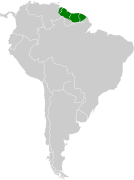
|
Size: About 6 cm (2 in), plus 5–6 cm (2 in) tail 4–5 cm (2 in) arm/wing length[117] Habitat: Forest[122] |
LC
|
| Hairy-tailed bat
|
L. ebenus Fazzolari-Corrêa, 1994 |
Brazil | Size: 5–7 cm (2–3 in), plus 5–6 cm (2 in) tail about 5 cm (2 in) arm/wing length[117] Habitat: Forest[123] |
DD
|
| Hoary bat | L. cinereus (Palisot de Beauvois, 1796) Three subspecies
|
North America and South America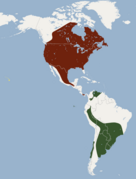
|
Size: 8–9 cm (3–4 in), plus 4–7 cm (2–3 in) tail 5–6 cm (2 in) arm/wing length[117] Habitat: Forest and caves[124] |
LC
|
| Jamaican red bat
|
L. degelidus Miller, 1931 |
Jamaica | Size: 5–6 cm (2 in), plus 5–6 cm (2 in) tail 4–5 cm (2 in) arm/wing length[117] Habitat: Forest[125] |
VU
|
| Minor red bat
|
L. minor Miller, 1931 |
Caribbean | Size: 4–7 cm (2–3 in), plus 3–5 cm (1–2 in) tail 3–5 cm (1–2 in) arm/wing length[117] Habitat: Forest[126] |
VU
|
| Northern yellow bat | L. intermedius (H. Allen, 1862) Two subspecies
|
Southern North America and Central America
|
Size: About 8 cm (3 in), plus 5–7 cm (2–3 in) tail 4–6 cm (2 in) arm/wing length[117] Habitat: Forest[127] |
LC
|
| Pfeiffer's red bat
|
L. pfeifferi Gundlach, 1861 |
Cuba | Size: 5–6 cm (2 in), plus 4–5 cm (2 in) tail 4–5 cm (2 in) arm/wing length[117] Habitat: Unknown[128] |
NT
|
| Saline red bat
|
L. salinae (Thomas, 1902) |
North America and South America | Size: 4–7 cm (2–3 in), plus 3–6 cm (1–2 in) tail 3–5 cm (1–2 in) arm/wing length[117] Habitat: Shrubland[129] |
DD
|
| Seminole bat | L. seminolus (Rhoads, 1895) |
Southeastern United States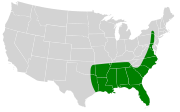
|
Size: 4–8 cm (2–3 in), plus 3–5 cm (1–2 in) tail 3–5 cm (1–2 in) arm/wing length[117] Habitat: Forest[130] |
LC
|
| Southern red bat | L. blossevillii (Lesson & Garnot, 1826) Four subspecies
|
North America and South America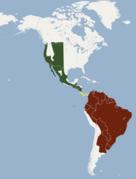
|
Size: 4–7 cm (2–3 in), plus 3–6 cm (1–2 in) tail 3–5 cm (1–2 in) arm/wing length[117] Habitat: Forest and savanna[131] |
LC
|
| Southern yellow bat | L. ega Gervais, 1856 Five subspecies
|
Mexico, Central America, and South America
|
Size: 5–8 cm (2–3 in), plus 4–7 cm (2–3 in) tail 4–6 cm (2 in) arm/wing length[117] Habitat: Forest[132] |
LC
|
| Tacarcuna bat
|
L. castaneus Handley, 1960 |
Central America | Size: 5–6 cm (2 in), plus 4–5 cm (2 in) tail 4–5 cm (2 in) arm/wing length[117] Habitat: Forest[133] |
DD
|
| Western yellow bat | L. xanthinus Thomas, 1897 |
Southern North America
|
Size: 6–8 cm (2–3 in), plus 4–5 cm (2 in) tail 4–5 cm (2 in) arm/wing length[117] Habitat: Forest and savanna[134] |
LC
|
| Common name | Scientific name and subspecies | Range | Size and ecology | IUCN status and estimated population |
|---|---|---|---|---|
| Moloney's mimic bat | M. moloneyi (Thomas, 1891) |
Sub-Saharan Africa | Size: 5–7 cm (2–3 in), plus 2–4 cm (1–2 in) tail 2–4 cm (1–2 in) arm/wing length[19] Habitat: Forest and savanna[135] |
LC
|
| Common name | Scientific name and subspecies | Range | Size and ecology | IUCN status and estimated population |
|---|---|---|---|---|
| Banana serotine | N. nana Peters, 1852 |
Sub-Saharan Africa | Size: 4–5 cm (2 in), plus 2–4 cm (1–2 in) tail 2–4 cm (1–2 in) arm/wing length[94] Habitat: Forest, savanna, and unknown[136] |
LC
|
| Cape serotine | N. capensis (A. Smith, 1829) |
Sub-Saharan Africa | Size: 4–8 cm (2–3 in), plus 2–4 cm (1–2 in) tail 2–4 cm (1–2 in) arm/wing length[7] Habitat: Forest, savanna, shrubland, and grassland[137] |
LC
|
| Dark-brown serotine
|
N. brunnea (Thomas, 1880) |
Western Africa | Size: 4–5 cm (2 in), plus 3–5 cm (1–2 in) tail 3–4 cm (1–2 in) arm/wing length[94] Habitat: Forest[138] |
NT
|
| Heller's serotine
|
N. helios (Heller, 1912) |
Eastern Africa | Size: 3–5 cm (1–2 in), plus 2–4 cm (1–2 in) tail 2–3 cm (1 in) arm/wing length[94] Habitat: Unknown[139] |
DD
|
| Isabelline white-winged serotine
|
N. isabella Decher, Hutterer, & Monadjem, 2015 |
Liberia | Size: 4–5 cm (2 in), plus 2–4 cm (1–2 in) tail 2–4 cm (1–2 in) arm/wing length[94] Habitat: Forest[140] |
DD
|
| Isalo serotine
|
N. malagasyensis (Peterson, Eger, & Mitchell, 1995) |
Madagascar
|
Size: Unknown length, plus about 3 cm (1 in) tail 3–4 cm (1–2 in) arm/wing length[7] Habitat: Forest[141] |
VU
|
| Malagasy serotine
|
N. matroka (Thomas & Schwann, 1905) |
Madagascar
|
Size: 4–6 cm (2 in), plus 2–4 cm (1–2 in) tail 2–4 cm (1–2 in) arm/wing length[7] Habitat: Forest[142] |
LC
|
| Melck's house bat
|
N. melckorum Roberts, 1919 |
Eastern Africa
|
Size: 4–8 cm (2–3 in), plus 2–4 cm (1–2 in) tail 2–4 cm (1–2 in) arm/wing length[7] Habitat: Savanna[143] |
DD
|
| Rendall's serotine | N. rendalli (Thomas, 1889) |
Sub-Saharan Africa | Size: 3–7 cm (1–3 in), plus 3–5 cm (1–2 in) tail 2–4 cm (1–2 in) arm/wing length[94] Habitat: Savanna and shrubland[144] |
LC
|
| Roberts's serotine
|
N. robertsi Goodman, Taylor, Ratrimomanarivo, & Hoofer, 2012 |
Madagascar
|
Size: 5–6 cm (2 in), plus 3–4 cm (1–2 in) tail 3–4 cm (1–2 in) arm/wing length[7] Habitat: Inland wetlands[145] |
DD
|
| Rosevear's serotine
|
N. roseveari (Monadjem, Richards, Taylor, & Stoffberg, 2013) |
Western Africa | Size: 4–5 cm (2 in), plus 3–5 cm (1–2 in) tail about 4 cm (2 in) arm/wing length[94] Habitat: Forest[146] |
EN
|
| Somali serotine | N. somalica (Thomas, 1901) |
Sub-Saharan Africa | Size: 3–6 cm (1–2 in), plus 2–4 cm (1–2 in) tail 2–4 cm (1–2 in) arm/wing length[7] Habitat: Forest and savanna[147] |
LC
|
| Tiny serotine | N. guineensis (Bocage, 1889) |
Sub-Saharan Africa | Size: 3–4 cm (1–2 in), plus 2–4 cm (1–2 in) tail 2–4 cm (1–2 in) arm/wing length[7] Habitat: Savanna and shrubland[148] |
LC
|
| White-winged serotine
|
N. tenuipinnis (Peters, 1872) |
Sub-Saharan Africa | Size: 3–5 cm (1–2 in), plus 2–4 cm (1–2 in) tail 2–4 cm (1–2 in) arm/wing length[94] Habitat: Forest and savanna[149] |
LC
|
| Yellow serotine
|
N. flavescens (Seabra, 1900) |
Southeastern Africa | Size: Habitat: Forest, savanna, and inland wetlands[150] |
DD
|
| Zulu serotine
|
N. zuluensis (Roberts, 1924) |
Southern and eastern Africa | Size: 4–5 cm (2 in), plus 2–4 cm (1–2 in) tail 2–4 cm (1–2 in) arm/wing length[7] Habitat: Forest, savanna, and desert[151] |
LC
|
| Common name | Scientific name and subspecies | Range | Size and ecology | IUCN status and estimated population |
|---|---|---|---|---|
| Azores noctule | N. azoreum Thomas, 1901 |
Azores islands | Size: 5–6 cm (2 in), plus 4–5 cm (2 in) tail 3–5 cm (1–2 in) arm/wing length[75] Habitat: Forest and inland wetlands[152] |
VU
|
| Birdlike noctule
|
N. aviator Thomas, 1911 |
Eastern Asia
|
Size: 8–11 cm (3–4 in), plus 4–7 cm (2–3 in) tail 5–7 cm (2–3 in) arm/wing length[75] Habitat: Forest[153] |
NT
|
| Chinese noctule | N. plancyi Gerbe, 1880 Two subspecies
|
Eastern Asia
|
Size: 6–9 cm (2–4 in), plus 3–6 cm (1–2 in) tail 4–5 cm (2 in) arm/wing length[75] Habitat: Forest, rocky areas, and caves[154] |
LC
|
| Common noctule | N. noctula (Schreber, 1774) Four subspecies
|
Europe and Asia
|
Size: 6–9 cm (2–4 in), plus 4–7 cm (2–3 in) tail 4–6 cm (2 in) arm/wing length[75] Habitat: Caves, inland wetlands, and forest[155] |
LC
|
| Greater noctule bat | N. lasiopterus (Schreber, 1780) |
Europe, northern Africa, and western Asia
|
Size: 8–11 cm (3–4 in), plus 4–8 cm (2–3 in) tail 5–7 cm (2–3 in) arm/wing length[75] Habitat: Forest and shrubland[156] Diet: Insects and birds[2] |
VU
|
| Japanese noctule
|
N. furvus Imaizumi & Yoshiyuki, 1968 |
Japan | Size: 7–9 cm (3–4 in), plus 4–6 cm (2 in) tail 4–6 cm (2 in) arm/wing length[75] Habitat: Forest[157] |
EN
|
| Lesser noctule | N. leisleri (Kuhl, 1817) Two subspecies
|
Europe, northern Africa, and western and central Asia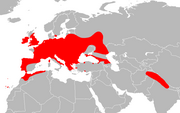
|
Size: 4–8 cm (2–3 in), plus 3–5 cm (1–2 in) tail 3–5 cm (1–2 in) arm/wing length[75] Habitat: Forest, shrubland, and rocky areas[158] |
LC
|
| Mountain noctule
|
N. montanus Barrett-Hamilton, 1906 |
Central Asia | Size: 6–7 cm (2–3 in), plus about 4 cm (2 in) tail 4–5 cm (2 in) arm/wing length[75] Habitat: Forest, rocky areas, and caves[159] |
LC
|
| Common name | Scientific name and subspecies | Range | Size and ecology | IUCN status and estimated population |
|---|---|---|---|---|
| Schlieffen's serotine | N. schlieffeni (Peters, 1869) |
Africa | Size: 3–5 cm (1–2 in), plus 2–4 cm (1–2 in) tail 2–4 cm (1–2 in) arm/wing length[94] Habitat: Savanna, shrubland, and desert[160] |
LC
|
| Common name | Scientific name and subspecies | Range | Size and ecology | IUCN status and estimated population |
|---|---|---|---|---|
| Cuban evening bat
|
N. cubanus Gundlach, 1861 |
Western Cuba | Size: About 5 cm (2 in), plus 2–4 cm (1–2 in) tail 2–4 cm (1–2 in) arm/wing length[161] Habitat: Unknown[162] |
NT
|
| Evening bat | N. humeralis (Rafinesque, 1818) Three subspecies
|
Southern North America
|
Size: About 6 cm (2 in), plus 3–5 cm (1–2 in) tail 3–4 cm (1–2 in) arm/wing length[161] Habitat: Forest[163] |
LC
|
| Temminck's mysterious bat
|
N. aenobarbus Temminck, 1840 |
South America | Size: About 4 cm (2 in), plus about 2 cm (1 in) tail about 3 cm (1 in) arm/wing length[161] Habitat: [164] |
DD
|
| Common name | Scientific name and subspecies | Range | Size and ecology | IUCN status and estimated population |
|---|---|---|---|---|
| Arnhem long-eared bat
|
N. arnhemensis Johnson, 1959 |
Northern Australia
|
Size: 4–6 cm (2 in), plus 3–5 cm (1–2 in) tail 3–4 cm (1–2 in) arm/wing length[19] Habitat: Forest and savanna[165] |
LC
|
| Eastern long-eared bat | N. bifax Thomas, 1915 Two subspecies
|
Eastern Australia and Papua New Guinea | Size: 3–6 cm (1–2 in), plus 3–5 cm (1–2 in) tail 3–5 cm (1–2 in) arm/wing length[19] Habitat: Forest and inland wetlands[166] |
LC
|
| Gould's long-eared bat | N. gouldi Tomes, 1858 |
Eastern and western Australia | Size: 4–6 cm (2 in), plus 3–5 cm (1–2 in) tail 3–5 cm (1–2 in) arm/wing length[19] Habitat: Forest[167] |
LC
|
| Greater long-eared bat
|
N. timoriensis Geoffroy, 1806 Three subspecies
|
Southeastern Asia | Size: 5–8 cm (2–3 in), plus 3–6 cm (1–2 in) tail 3–5 cm (1–2 in) arm/wing length[19] Habitat: Forest |
NE
|
| Holts' long-eared bat
|
N. holtorum Parnaby, King, & Eldridge, 2021 |
Western Australia | Size: Unknown length, plus about 5 cm (2 in) tail about 4 cm (2 in) arm/wing length[19] Habitat: Forest[168] |
LC
|
| Lesser long-eared bat | N. geoffroyi Leach, 1821 Three subspecies
|
Australia | Size: 3–5 cm (1–2 in), plus 3–4 cm (1–2 in) tail 3–5 cm (1–2 in) arm/wing length[19] Habitat: Forest, savanna, shrubland, and grassland[169] |
LC
|
| Lord Howe long-eared bat†
|
N. howensis McKean, 1975 |
Lord Howe Island in Australia
|
Size: Unknown length Habitat: Unknown[170] |
EX
|
| Mount Missim long-eared bat
|
N. shirleyae Parnaby, 2009 |
Papua New Guinea
|
Size: 5–7 cm (2–3 in), plus 4–6 cm (2 in) tail 4–5 cm (2 in) arm/wing length[19] Habitat: Forest[171] |
DD
|
| New Caledonian long-eared bat
|
N. nebulosus Parnaby, 2002. |
New Caledonia | Size: 5–6 cm (2 in), plus 4–5 cm (2 in) tail 4–5 cm (2 in) arm/wing length[19] Habitat: Forest[172] |
CR
|
| New Guinea long-eared bat
|
N. microtis Thomas, 1888 |
Papua New Guinea
|
Size: 4–7 cm (2–3 in), plus 3–5 cm (1–2 in) tail 3–5 cm (1–2 in) arm/wing length[19] Habitat: Forest and caves[173] |
LC
|
| Pallid long-eared bat
|
N. daedalus Thomas, 1915 |
Northern Australia | Size: 4–6 cm (2 in), plus 4–5 cm (2 in) tail 3–5 cm (1–2 in) arm/wing length[19] Habitat: Forest and inland wetlands[174] |
LC
|
| Pygmy long-eared bat
|
N. walkeri Thomas, 1892 |
Northern Australia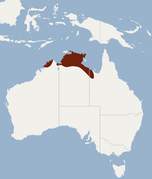
|
Size: 3–5 cm (1–2 in), plus 2–4 cm (1–2 in) tail 3–4 cm (1–2 in) arm/wing length[19] Habitat: Forest and savanna[175] |
LC
|
| Small-toothed long-eared bat
|
N. microdon Laurie & Hill, 1954 |
Papua New Guinea
|
Size: 4–7 cm (2–3 in), plus 3–5 cm (1–2 in) tail 3–5 cm (1–2 in) arm/wing length[19] Habitat: Caves[176] |
LC
|
| Southeastern long-eared bat | N. corbeni Parnaby, 2009 |
Australia | Size: 5–8 cm (2–3 in), plus 3–6 cm (1–2 in) tail 3–5 cm (1–2 in) arm/wing length[19] Habitat: Forest[177] |
VU
|
| Sunda long-eared bat
|
N. heran Kitchener, How, & Maharadatunkamsi, 1991 |
Indonesia | Size: About 5 cm (2 in), plus about 4 cm (2 in) tail about 4 cm (2 in) arm/wing length[19] Habitat: Forest[178] |
DD
|
| Tasmanian long-eared bat
|
N. sherrini Thomas, 1915 |
Tasmania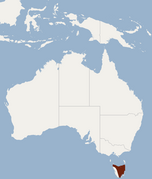
|
Size: 5–6 cm (2 in), plus 3–4 cm (1–2 in) tail 4–5 cm (2 in) arm/wing length[19] Habitat: Forest[179] |
VU
|
| Western long-eared bat | N. major Gray, 1844 |
Southwestern Australia | Size: 5–7 cm (2–3 in), plus 4–6 cm (2 in) tail 3–5 cm (1–2 in) arm/wing length[19] Habitat: Forest[180] |
LC
|
| Common name | Scientific name and subspecies | Range | Size and ecology | IUCN status and estimated population |
|---|---|---|---|---|
| Desert long-eared bat | O. hemprichii Peters, 1859 |
Northern Africa and western Asia | Size: 5–9 cm (2–4 in), plus 4–7 cm (2–3 in) tail 5–7 cm (2–3 in) arm/wing length[28] Habitat: Shrubland, rocky areas, and desert[181] |
LC
|
| Turkestani long-eared bat
|
O. leucophaea (N. A. Severcov, 1873) |
Western Asia | Size: 7–8 cm (3 in), plus 4–7 cm (2–3 in) tail 5–7 cm (2–3 in) arm/wing length[28] Habitat: Desert and grassland[182] |
DD
|
| Common name | Scientific name and subspecies | Range | Size and ecology | IUCN status and estimated population |
|---|---|---|---|---|
| Canyon bat | P. hesperus (H. Allen, 1864) |
Western United States and Mexico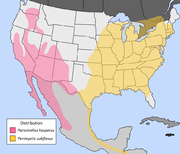
|
Size: 3–6 cm (1–2 in), plus 2–4 cm (1–2 in) tail 2–4 cm (1–2 in) arm/wing length[5] Habitat: Forest, grassland, rocky areas, caves, and desert[183] |
LC
|
| Common name | Scientific name and subspecies | Range | Size and ecology | IUCN status and estimated population |
|---|---|---|---|---|
| Tricolored bat | P. subflavus (F. Cuvier, 1832) Four subspecies
|
Eastern North America
|
Size: 4–5 cm (2 in), plus 3–5 cm (1–2 in) tail 3–4 cm (1–2 in) arm/wing length[5] Habitat: Forest, rocky areas, and caves[184] |
VU
|
| Common name | Scientific name and subspecies | Range | Size and ecology | IUCN status and estimated population |
|---|---|---|---|---|
| New Guinea big-eared bat
|
P. imogene Thomas, 1914 |
Papua New Guinea
|
Size: 4–5 cm (2 in), plus 4–5 cm (2 in) tail 3–4 cm (1–2 in) arm/wing length[19] Habitat: Forest[185] |
CR
|
| Common name | Scientific name and subspecies | Range | Size and ecology | IUCN status and estimated population |
|---|---|---|---|---|
| Rohu's bat | P. brachypterus Temminck, 1840 |
Southeastern Asia
|
Size: 5–7 cm (2–3 in), plus 3–4 cm (1–2 in) tail 3–4 cm (1–2 in) arm/wing length[21] Habitat: Forest and grassland[186] |
LC
|
| Common name | Scientific name and subspecies | Range | Size and ecology | IUCN status and estimated population |
|---|---|---|---|---|
| Aellen's pipistrelle
|
P. inexspectatus Aellen, 1959 |
Western Africa | Size: About 5 cm (2 in), plus 3–4 cm (1–2 in) tail 3–4 cm (1–2 in) arm/wing length[187] Habitat: Forest and savanna[188] |
DD
|
| Angulate pipistrelle
|
P. angulatus Peters, 1880 Two subspecies
|
Papua New Guinea and the Solomon Islands | Size: 3–5 cm (1–2 in), plus 2–5 cm (1–2 in) tail 3–4 cm (1–2 in) arm/wing length[187] Habitat: Forest and caves[189] |
LC
|
| Broad-headed serotine
|
P. crassulus (Thomas, 1904) |
Central and western Africa | Size: 4–6 cm (2 in), plus 2–4 cm (1–2 in) tail 2–4 cm (1–2 in) arm/wing length[94] Habitat: Forest[96] |
LC
|
| Christmas Island pipistrelle†
|
P. murrayi (Andrews, 1900) |
Christmas Island in Australia | Size: Unknown length Habitat: Forest[190] |
EX
|
| Common pipistrelle | P. pipistrellus (Schreber, 1774) Two subspecies
|
Europe, northern Africa, and Asia | Size: 3–6 cm (1–2 in), plus 2–4 cm (1–2 in) tail 2–4 cm (1–2 in) arm/wing length[75] Habitat: Forest, shrubland, inland wetlands, and caves[191] |
LC
|
| Dar es Salaam pipistrelle
|
P. permixtus Aellen, 1957 |
Tanzania | Size: About 4 cm (2 in), plus about 3 cm (1 in) tail about 3 cm (1 in) arm/wing length[187] Habitat: Forest[192] |
DD
|
| Dobson's pipistrelle
|
P. grandidieri (Dobson, 1876) |
Western and eastern Africa | Size: 5–6 cm (2 in), plus 3–4 cm (1–2 in) tail 3–4 cm (1–2 in) arm/wing length[94] Habitat: Forest, savanna, and inland wetlands[193] |
DD
|
| Dusky pipistrelle
|
P. hesperidus (Temminck, 1840) Three subspecies
|
Madagascar
|
Size: 4–6 cm (2 in), plus 2–5 cm (1–2 in) tail 2–4 cm (1–2 in) arm/wing length[187] Habitat: Forest and savanna[194] |
LC
|
| Endo's pipistrelle
|
P. endoi Imaizumi, 1959 |
Japan
|
Size: 4–5 cm (2 in), plus 2–4 cm (1–2 in) tail 3–4 cm (1–2 in) arm/wing length[187] Habitat: Forest and other[195] |
NT
|
| Forest pipistrelle
|
P. adamsi Kitchener, Caputi, & Jones, 1986 |
Northern Australia
|
Size: 3–5 cm (1–2 in), plus 2–4 cm (1–2 in) tail 2–4 cm (1–2 in) arm/wing length[187] Habitat: Savanna and forest[196] |
LC
|
| Greater Papuan pipistrelle
|
P. collinus Thomas, 1920 |
Island of New Guinea | Size: 3–6 cm (1–2 in), plus 3–5 cm (1–2 in) tail 3–4 cm (1–2 in) arm/wing length[187] Habitat: Forest[197] |
LC
|
| Hanak's pipistrelle
|
P. hanaki Hulva & Benda, 2004 |
Crete and Libya | Size: 4–5 cm (2 in), plus 3–4 cm (1–2 in) tail 3–4 cm (1–2 in) arm/wing length[187] Habitat: Forest, shrubland, inland wetlands, and rocky areas[198] |
VU
|
| Indian pipistrelle | P. coromandra Gray, 1838 |
Southern and southeastern Asia
|
Size: 3–5 cm (1–2 in), plus 2–4 cm (1–2 in) tail 2–4 cm (1–2 in) arm/wing length[187] Habitat: Forest and caves[199] |
LC
|
| Japanese house bat | P. abramus (Temminck, 1840) |
Eastern Asia
|
Size: 3–6 cm (1–2 in), plus 2–5 cm (1–2 in) tail 2–4 cm (1–2 in) arm/wing length[187] Habitat: Forest, grassland, inland wetlands, and intertidal marine[200] |
LC
|
| Java pipistrelle
|
P. javanicus Gray, 1838 Five subspecies
|
Southern and southeastern Asia
|
Size: 4–6 cm (2 in), plus 2–4 cm (1–2 in) tail 2–4 cm (1–2 in) arm/wing length[187] Habitat: Caves and forest[201] |
LC
|
| Kelaart's pipistrelle
|
P. ceylonicus Kelaart, 1852 Seven subspecies
|
Southern and southeastern Asia | Size: 4–7 cm (2–3 in), plus 3–5 cm (1–2 in) tail 3–5 cm (1–2 in) arm/wing length[187] Habitat: Forest and caves[202] |
LC
|
| Kuhl's pipistrelle | P. kuhlii Kuhl, 1817 Three subspecies
|
Europe, western Asia, northern Africa, and Madagascar
|
Size: 4–6 cm (2 in), plus 3–5 cm (1–2 in) tail 3–4 cm (1–2 in) arm/wing length[187] Habitat: Forest, shrubland, and grassland[203] |
LC
|
| Least pipistrelle | P. tenuis (Temminck, 1840) Eight subspecies
|
Southern and southeastern Asia | Size: 3–5 cm (1–2 in), plus 2–4 cm (1–2 in) tail 2–4 cm (1–2 in) arm/wing length[187] Habitat: Forest, shrubland, and grassland[204] |
LC
|
| Lesser Papuan pipistrelle
|
P. papuanus Peters & Doria, 1881 |
Indonesia and Papua New Guinea | Size: 3–5 cm (1–2 in), plus 2–4 cm (1–2 in) tail 2–4 cm (1–2 in) arm/wing length[187] Habitat: Forest[205] |
LC
|
| Madeira pipistrelle
|
P. maderensis Dobson, 1878 |
Azores, Madeira Island and the Canary Islands
|
Size: 3–5 cm (1–2 in), plus 3–4 cm (1–2 in) tail 2–4 cm (1–2 in) arm/wing length[187] Habitat: Forest and inland wetlands[206] |
EN
|
| Minahassa pipistrelle
|
P. minahassae von Meyer, 1899 |
Indonesia | Size: About 6 cm (2 in), plus about 4 cm (2 in) tail about 4 cm (2 in) arm/wing length[187] Habitat: Unknown[207] |
DD
|
| Mount Gargues pipistrelle
|
P. aero Heller, 1912 |
Kenya and Ethiopia | Size: 4–5 cm (2 in), plus 3–4 cm (1–2 in) tail 3–4 cm (1–2 in) arm/wing length[187] Habitat: Forest[208] |
DD
|
| Mount Popa pipistrelle
|
P. paterculus Thomas, 1915 Two subspecies
|
Southern and southeastern Asia
|
Size: 4–5 cm (2 in), plus 3–4 cm (1–2 in) tail 2–4 cm (1–2 in) arm/wing length[187] Habitat: Forest[209] |
LC
|
| Narrow-winged pipistrelle | P. stenopterus Dobson, 1875 |
Southeastern Asia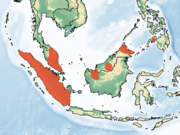
|
Size: 5–7 cm (2–3 in), plus 3–6 cm (1–2 in) tail 3–5 cm (1–2 in) arm/wing length[187] Habitat: Forest, shrubland, grassland, and inland wetlands[210] |
LC
|
| Nathusius's pipistrelle | P. nathusii (Keyserling & Blasius, 1839) |
Europe | Size: 4–6 cm (2 in), plus 3–4 cm (1–2 in) tail 3–4 cm (1–2 in) arm/wing length[187] Habitat: Forest and inland wetlands[211] |
LC
|
| Northern pipistrelle
|
P. westralis Koopman, 1984 |
Northern Australia
|
Size: 3–5 cm (1–2 in), plus 2–4 cm (1–2 in) tail 2–4 cm (1–2 in) arm/wing length[187] Habitat: Forest[212] |
LC
|
| Racey's pipistrelle
|
P. raceyi Bates, Ratrimomanarivo, Harrison, & Goodman, 2006 |
Madagascar
|
Size: 4–6 cm (2 in), plus 2–4 cm (1–2 in) tail 2–4 cm (1–2 in) arm/wing length[187] Habitat: Forest[213] |
DD
|
| Rüppell's bat | P. rueppellii J. B. Fischer, 1829 Six subspecies
|
Africa and southwestern Asia | Size: 4–6 cm (2 in), plus 2–5 cm (1–2 in) tail 2–4 cm (1–2 in) arm/wing length[75] Habitat: Desert, shrubland, and savanna[214] |
LC
|
| Rusty pipistrelle
|
P. rusticus (Tomes, 1861) Two subspecies
|
Sub-Saharan Africa | Size: 4–5 cm (2 in), plus 1–4 cm (0.4–1.6 in) tail 2–4 cm (1–2 in) arm/wing length[187] Habitat: Forest and savanna[215] |
LC
|
| Soprano pipistrelle | P. pygmaeus (Leach, 1825) |
Europe
|
Size: 3–6 cm (1–2 in), plus 2–4 cm (1–2 in) tail 2–4 cm (1–2 in) arm/wing length[187] Habitat: Forest and inland wetlands[216] |
LC
|
| Sturdee's pipistrelle†
|
P. sturdeei Thomas, 1915 |
Japan | Size: Unknown length Habitat: Unknown[217] |
EX
|
| Tiny pipistrelle
|
P. nanulus Thomas, 1904 |
Western and central Africa | Size: 3–5 cm (1–2 in), plus 2–4 cm (1–2 in) tail 2–4 cm (1–2 in) arm/wing length[187] Habitat: Forest and savanna[218] |
LC
|
| Watts's pipistrelle
|
P. wattsi Kitchener, Caputi, & Jones, 1986 |
Papua New Guinea | Size: 3–5 cm (1–2 in), plus 1–3 cm (0.4–1.2 in) tail 2–4 cm (1–2 in) arm/wing length[187] Habitat: Forest[219] |
LC
|
| Common name | Scientific name and subspecies | Range | Size and ecology | IUCN status and estimated population |
|---|---|---|---|---|
| Alpine long-eared bat | P. macrobullaris Kuzyakin, 1965 |
Central Europe | Size: 4–6 cm (2 in), plus 4–6 cm (2 in) tail 3–5 cm (1–2 in) arm/wing length[28] Habitat: Caves, grassland, shrubland, and forest[220] |
LC
|
| Brown long-eared bat | P. auritus (Linnaeus, 1758) |
Europe and western Asia
|
Size: 3–5 cm (1–2 in), plus 3–5 cm (1–2 in) tail 3–5 cm (1–2 in) arm/wing length[28] Habitat: Forest and caves[221] |
LC
|
| Canary long-eared bat | P. teneriffae Barrett-Hamilton, 1907 |
Canary Islands
|
Size: 4–6 cm (2 in), plus 4–6 cm (2 in) tail 4–5 cm (2 in) arm/wing length[28] Habitat: Forest and caves[222] |
CR
|
| Christie's long-eared bat
|
P. christii Gray, 1838 |
Northern Africa and western Asia | Size: 4–6 cm (2 in), plus 4–5 cm (2 in) tail 3–5 cm (1–2 in) arm/wing length[28] Habitat: Shrubland, rocky areas, and desert[223] |
DD
|
| Ethiopian long-eared bat
|
P. balensis Kruskop & Lavrenchenko, 2000 |
Ethiopia | Size: 4–5 cm (2 in), plus 4–6 cm (2 in) tail 3–5 cm (1–2 in) arm/wing length[28] Habitat: Forest[224] |
DD
|
| Grey long-eared bat | P. austriacus (J. B. Fischer, 1829) |
Europe
|
Size: 4–6 cm (2 in), plus 3–6 cm (1–2 in) tail 3–5 cm (1–2 in) arm/wing length[28] Habitat: Forest, shrubland, grassland, and caves[225] |
NT
|
| Himalayan long-eared bat
|
P. homochrous Hodgson, 1847 |
Southern and eastern Asia | Size: 4–5 cm (2 in), plus 4–5 cm (2 in) tail 3–5 cm (1–2 in) arm/wing length[28] Habitat: Forest[226] |
DD
|
| Japanese long-eared bat
|
P. sacrimontis Allen, 1908 |
Japan | Size: 4–6 cm (2 in), plus 4–6 cm (2 in) tail 3–5 cm (1–2 in) arm/wing length[28] Habitat: Forest and caves[227] |
LC
|
| Kozlov's long-eared bat
|
P. kozlovi Bóbrinski, 1926 |
Eastern Asia | Size: Unknown length, plus 4–6 cm (2 in) tail 4–5 cm (2 in) arm/wing length[28] Habitat: Savanna, rocky areas, and desert[228] |
LC
|
| Mediterranean long-eared bat | P. kolombatovici Đulić, 1980 |
Southern Europe and western Asia | Size: 4–5 cm (2 in), plus 4–5 cm (2 in) tail 3–4 cm (1–2 in) arm/wing length[28] Habitat: Forest, shrubland, grassland, and caves[229] |
LC
|
| Ognev's long-eared bat | P. ognevi Kishida, 1927 |
Eastern Asia | Size: 4–5 cm (2 in), plus 4–5 cm (2 in) tail 4–5 cm (2 in) arm/wing length[28] Habitat: Forest, caves, grassland, and shrubland[230] |
LC
|
| Sardinian long-eared bat | P. sardus Mucedda, Kiefer, Pidinchedda, & Veith, 2002 |
Sardinia island in Italy | Size: About 5 cm (2 in), plus about 5 cm (2 in) tail 4–5 cm (2 in) arm/wing length[28] Habitat: Forest and caves[231] |
CR
|
| Strelkov's long-eared bat
|
P. strelkovi Spitzenberger, 2006 |
Central Asia | Size: 4–6 cm (2 in), plus 4–6 cm (2 in) tail 4–5 cm (2 in) arm/wing length[28] Habitat: Forest[232] |
LC
|
| Taiwan long-eared bat
|
P. taivanus Yoshiyuki, 1991 |
Taiwan | Size: 4–5 cm (2 in), plus 4–5 cm (2 in) tail 3–4 cm (1–2 in) arm/wing length[28] Habitat: Forest[233] |
NT
|
| Turkmen long-eared bat
|
P. turkmenicus Strelkov, 1988 |
Western Asia
|
Size: About 6 cm (2 in), plus about 5 cm (2 in) tail about 5 cm (2 in) arm/wing length[28] Habitat: Desert[234] |
LC
|
| Ward's long-eared bat
|
P. wardi Thomas, 1911 |
South Asia | Size: 4–6 cm (2 in), plus 4–6 cm (2 in) tail 4–5 cm (2 in) arm/wing length[28] Habitat: Forest, shrubland, and caves[235] |
LC
|
| Common name | Scientific name and subspecies | Range | Size and ecology | IUCN status and estimated population |
|---|---|---|---|---|
| Bickham's little yellow bat
|
R. bickhami Baird, Marchán-Rivadeneira, Pérez, & Baker, 2012 |
Central America
|
Size: 4–5 cm (2 in), plus 2–4 cm (1–2 in) tail 2–3 cm (1 in) arm/wing length[5] Habitat: Forest[236] |
LC
|
| Black-winged little yellow bat | R. tumida H. Allen, 1866 |
Mexico and Central America
|
Size: 3–5 cm (1–2 in), plus 2–4 cm (1–2 in) tail 2–4 cm (1–2 in) arm/wing length[5] Habitat: Forest[237] |
LC
|
| Ecuadorian little yellow bat
|
R. velilla Thomas, 1903 |
Peru and Ecuador | Size: 3–5 cm (1–2 in), plus 2–4 cm (1–2 in) tail 2–4 cm (1–2 in) arm/wing length[5] Habitat: Forest[238] |
DD
|
| Genoways's yellow bat | R. genowaysi Baker, 1984 |
Southern Mexico
|
Size: 3–5 cm (1–2 in), plus 2–4 cm (1–2 in) tail 2–3 cm (1 in) arm/wing length[5] Habitat: Forest[239] |
EN
|
| Husson's yellow bat
|
R. hussoni Genoways & Baker, 1996 |
Eastern South America
|
Size: Unknown length about 3 cm (1 in) arm/wing length[5] Habitat: Forest[240] |
DD
|
| Least yellow bat
|
R. mira LaVal, 1973 |
Southern Mexico
|
Size: 3–4 cm (1–2 in), plus 2–4 cm (1–2 in) tail 2–3 cm (1 in) arm/wing length[5] Habitat: Forest[241] |
VU
|
| Little yellow bat | R. parvula H. Allen, 1866 |
Western Mexico
|
Size: 4–5 cm (2 in), plus 2–4 cm (1–2 in) tail 2–3 cm (1 in) arm/wing length[5] Habitat: Forest[242] |
LC
|
| Menchu's little yellow bat
|
R. menchuae Baird, Marchán-Rivadeneira, Pérez, & Baker, 2012 |
Central America
|
Size: 4–5 cm (2 in), plus 2–4 cm (1–2 in) tail 2–3 cm (1 in) arm/wing length[5] Habitat: Forest[243] |
DD
|
| Thomas's yellow bat | R. io Thomas, 1903 |
Central America and South America
|
Size: 3–5 cm (1–2 in), plus 2–4 cm (1–2 in) tail 2–4 cm (1–2 in) arm/wing length[5] Habitat: Forest[244] |
LC
|
| Tiny yellow bat
|
R. minutilla Miller, 1897 |
Colombia and Venezuela
|
Size: 4–5 cm (2 in), plus 2–4 cm (1–2 in) tail 2–3 cm (1 in) arm/wing length[5] Habitat: Forest and shrubland[245] |
VU
|
| Yucatan yellow bat | R. aenea Goodwin, 1958 |
Southern Mexico and northern Central America
|
Size: 3–5 cm (1–2 in), plus 2–4 cm (1–2 in) tail 2–4 cm (1–2 in) arm/wing length[5] Habitat: Forest[246] |
LC
|
| Common name | Scientific name and subspecies | Range | Size and ecology | IUCN status and estimated population |
|---|---|---|---|---|
| Sind bat
|
R. nasutus (Dobson, 1877) Four subspecies
|
Western Asia | Size: 4–6 cm (2 in), plus 3–5 cm (1–2 in) tail 3–4 cm (1–2 in) arm/wing length[7] Habitat: Forest, savanna, caves, and desert[247] |
LC
|
| Common name | Scientific name and subspecies | Range | Size and ecology | IUCN status and estimated population |
|---|---|---|---|---|
| Rüppell's broad-nosed bat | S. rueppellii (Peters, 1866) |
Eastern Mexico
|
Size: 6–8 cm (2–3 in), plus 4–6 cm (2 in) tail 5–6 cm (2 in) arm/wing length[63] Habitat: Forest[248] |
LC
|
| Common name | Scientific name and subspecies | Range | Size and ecology | IUCN status and estimated population |
|---|---|---|---|---|
| Dark-winged lesser house bat
|
S. hirundo De Winton, 1899 |
Sub-Saharan Africa | Size: About4 cm (2 in), plus tail about 3 cm (1 in) arm/wing length[75] Habitat: Savanna and forest[249] |
LC
|
| Desert yellow bat
|
S. pallidus Dobson, 1876 |
Southern Asia | Size: 4–6 cm (2 in), plus 2–5 cm (1–2 in) tail 3–4 cm (1–2 in) arm/wing length[75] Habitat: Forest and shrubland[250] |
LC
|
| Hinde's lesser house bat
|
S. hindei Thomas, 1901 Two subspecies
|
Sub-Saharan Africa | Size: Unknown length 3–4 cm (1–2 in) arm/wing length[75] Habitat: Savanna and forest[251] |
LC
|
| Light-winged lesser house bat
|
S. albofuscus Thomas, 1890 Two subspecies
|
Western and southeastern Africa | Size: 4–6 cm (2 in), plus 2–5 cm (1–2 in) tail 2–4 cm (1–2 in) arm/wing length[75] Habitat: Forest and savanna[252] |
DD
|
| White-bellied lesser house bat
|
S. albigula Thomas, 1909 |
Sub-Saharan Africa | Size: About 6 cm (2 in), plus about 3 cm (1 in) tail About 4 cm (2 in) arm/wing length[75] Habitat: Forest and savanna[253] |
LC
|
| Common name | Scientific name and subspecies | Range | Size and ecology | IUCN status and estimated population |
|---|---|---|---|---|
| Harlequin bat | S. ornatus (Blyth, 1851) Three subspecies
|
Eastern and southeastern Asia
|
Size: 6–9 cm (2–4 in), plus 5–7 cm (2–3 in) tail 5–7 cm (2–3 in) arm/wing length[63] Habitat: Forest and caves[254] |
LC
|
| Common name | Scientific name and subspecies | Range | Size and ecology | IUCN status and estimated population |
|---|---|---|---|---|
| African yellow bat | S. dinganii A. Smith, 1833 Four subspecies
|
Sub-Saharan Africa | Size: 7–9 cm (3–4 in), plus 4–7 cm (2–3 in) tail 4–6 cm (2 in) arm/wing length[161] Habitat: Savanna[255] |
LC
|
| Andrew Rebori's house bat
|
S. andrewreborii Brooks & Bickham, 2014 |
Eastern Africa
|
Size: 7–9 cm (3–4 in), plus 4–5 cm (2 in) tail 4–6 cm (2 in) arm/wing length[161] Habitat: Forest and savanna[256] |
LC
|
| Eastern greenish yellow bat | S. viridis (Peters, 1852) Two subspecies
|
Sub-Saharan Africa | Size: 7–9 cm (3–4 in), plus 3–5 cm (1–2 in) tail 4–6 cm (2 in) arm/wing length[161] Habitat: Savanna[257] |
LC
|
| Ejeta's yellow bat
|
S. ejetai Brooks & Bickham, 2014 |
Ethiopia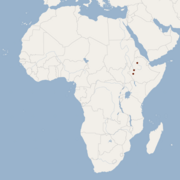
|
Size: 7–8 cm (3 in), plus 4–5 cm (2 in) tail 5–6 cm (2 in) arm/wing length[161] Habitat: Grassland, shrubland, and savanna[258] |
LC
|
| Greater Asiatic yellow bat | S. heathii Horsfield, 1831 Three subspecies
|
Southern and southeastern Asia
|
Size: 6–10 cm (2–4 in), plus 4–8 cm (2–3 in) tail 5–7 cm (2–3 in) arm/wing length[117] Habitat: Forest, shrubland, and desert[259] |
LC
|
| Lesser Asiatic yellow bat | S. kuhlii Leach, 1821 Seven subspecies
|
Southern and southeastern Asia
|
Size: 5–9 cm (2–4 in), plus 3–7 cm (1–3 in) tail 4–6 cm (2 in) arm/wing length[117] Habitat: Forest, shrubland, and desert[260] |
LC
|
| Lesser yellow bat | S. borbonicus Geoffroy, 1803 |
Madagascar
|
Size: Unknown length Habitat: Unknown[261] |
DD
|
| Livingstone's yellow bat
|
S. livingstonii Brooks & Bickham, 2014 |
Western Africa | Size: 7–9 cm (3–4 in), plus 3–6 cm (1–2 in) tail 5–6 cm (2 in) arm/wing length[161] Habitat: Grassland, savanna, and forest[262] |
LC
|
| Malagasy yellow bat
|
S. tandrefana Goodman, Jenkin, & Ratrimomanarivo, 2005 |
Madagascar
|
Size: 6–7 cm (2–3 in), plus 4–5 cm (2 in) tail 4–5 cm (2 in) arm/wing length[117] Habitat: Forest[263] |
DD
|
| Marovaza yellow bat
|
S. marovaza Goodman, Ratrimomanarivo, & Randrianandrianina, 2006 |
Madagascar
|
Size: 6–7 cm (2–3 in), plus 3–5 cm (1–2 in) tail 4–5 cm (2 in) arm/wing length[117] Habitat: Forest[264] |
LC
|
| Nut-colored yellow bat
|
S. nux Thomas, 1904 |
Western and central Africa | Size: 6–9 cm (2–4 in), plus 4–6 cm (2 in) tail 5–7 cm (2–3 in) arm/wing length[117] Habitat: Forest[265] |
LC
|
| Robbins's yellow bat
|
S. nucella Robbins, 1984 |
Western Africa | Size: 7–8 cm (3 in), plus 4–5 cm (2 in) tail 4–6 cm (2 in) arm/wing length[161] Habitat: Forest[266] |
DD
|
| Robust yellow bat | S. robustus H. Milne-Edwards, 1881 |
Madagascar
|
Size: 9–10 cm (4 in), plus 5–7 cm (2–3 in) tail 6–7 cm (2–3 in) arm/wing length[161] Habitat: Forest[267] |
LC
|
| Schreber's yellow bat | S. nigrita (Schreber, 1774) Two subspecies
|
Western and eastern Africa | Size: 10–13 cm (4–5 in), plus 6–10 cm (2–4 in) tail 7–9 cm (3–4 in) arm/wing length[161] Habitat: Forest and savanna[268] |
LC
|
| Sody's yellow bat | S. collinus Sody, 1936 |
Southeastern Asia | Size: 5–8 cm (2–3 in), plus 2–6 cm (1–2 in) tail 4–6 cm (2 in) arm/wing length[117] Habitat: Forest[269] |
LC
|
| Sulawesi yellow bat
|
S. celebensis (Sody, 1928) |
Sulawesi island in Indonesia | Size: 6–10 cm (2–4 in), plus 4–8 cm (2–3 in) tail 5–7 cm (2–3 in) arm/wing length[117] Habitat: Forest[270] |
DD
|
| Trujillo's yellow bat
|
S. trujilloi Brooks & Bickham, 2014 |
Kenya
|
Size: 6–8 cm (2–3 in), plus 3–5 cm (1–2 in) tail 4–5 cm (2 in) arm/wing length[161] Habitat: Forest[271] |
LC
|
| White-bellied yellow bat | S. leucogaster Cretzschmar, 1826 Two subspecies
|
Sub-Saharan Africa | Size: 7–8 cm (3 in), plus 3–6 cm (1–2 in) tail 4–6 cm (2 in) arm/wing length[117] Habitat: Savanna[272] |
LC
|
| Common name | Scientific name and subspecies | Range | Size and ecology | IUCN status and estimated population |
|---|---|---|---|---|
| Eastern broad-nosed bat
|
S. orion (Troughton, 1937) |
Eastern Australia | Size: 4–6 cm (2 in), plus 2–4 cm (1–2 in) tail 3–4 cm (1–2 in) arm/wing length[63] Habitat: Forest[273] |
LC
|
| Inland broad-nosed bat | S. balstoni (Thomas, 1906) Two subspecies
|
Australia
|
Size: 4–6 cm (2 in), plus 2–5 cm (1–2 in) tail 3–4 cm (1–2 in) arm/wing length[63] Habitat: Forest, savanna, shrubland, and desert[274] |
LC
|
| Little broad-nosed bat | S. greyii Gray, 1842 |
Australia | Size: 3–6 cm (1–2 in), plus 2–5 cm (1–2 in) tail 2–4 cm (1–2 in) arm/wing length[63] Habitat: Desert, grassland, shrubland, savanna, and forest[275] |
LC
|
| Northern broad-nosed bat
|
S. sanborni (Troughton, 1937) |
Northern Australia, Timor-Leste, and Papua New Guinea
|
Size: 3–6 cm (1–2 in), plus 2–4 cm (1–2 in) tail 2–4 cm (1–2 in) arm/wing length[63] Habitat: Forest and savanna[276] |
LC
|
| Common name | Scientific name and subspecies | Range | Size and ecology | IUCN status and estimated population |
|---|---|---|---|---|
| Dormer's bat
|
S. dormeri Dobson, 1875 |
Southern Asia | Size: 3–6 cm (1–2 in), plus 2–5 cm (1–2 in) tail 3–4 cm (1–2 in) arm/wing length[75] Habitat: Forest, shrubland, and desert[277] |
LC
|
| Common name | Scientific name and subspecies | Range | Size and ecology | IUCN status and estimated population |
|---|---|---|---|---|
| Collared sprite
|
T. aureocollaris Kock & Storch, 1996 |
Laos and Thailand | Size: 6–7 cm (2–3 in), plus 4–6 cm (2 in) tail 4–6 cm (2 in) arm/wing length[7] Habitat: Forest[278] |
LC
|
| Common name | Scientific name and subspecies | Range | Size and ecology | IUCN status and estimated population |
|---|---|---|---|---|
| Pygmy bamboo bat
|
T. pygmaea Feng, Li, & Wang, 2008 |
Southeastern Asia
|
Size: 2–4 cm (1–2 in), plus 2–3 cm (1 in) tail 2–3 cm (1 in) arm/wing length[21] Habitat: Unknown[279] |
DD
|
| Greater bamboo bat | T. robustula Thomas, 1915 Two subspecies
|
Southeastern Asia
|
Size: 4–5 cm (2 in), plus 2–4 cm (1–2 in) tail 2–3 cm (1 in) arm/wing length[21] Habitat: Forest[280] |
LC
|
| Lesser bamboo bat | T. pachypus (Temminck, 1840) Five subspecies
|
Southeastern Asia
|
Size: 3–5 cm (1–2 in), plus 2–4 cm (1–2 in) tail 2–3 cm (1 in) arm/wing length[21] Habitat: Forest[281] |
LC
|
| Common name | Scientific name and subspecies | Range | Size and ecology | IUCN status and estimated population |
|---|---|---|---|---|
| Eastern cave bat | V. troughtoni (Kitchener, Jones, & Caputi, 1987) |
Eastern Australia | Size: 3–5 cm (1–2 in), plus 3–4 cm (1–2 in) tail 3–4 cm (1–2 in) arm/wing length[21] Habitat: Forest and caves[282] |
LC
|
| Eastern forest bat | V. pumilus Gray, 1841 |
Eastern Australia | Size: 3–5 cm (1–2 in), plus 2–4 cm (1–2 in) tail 2–4 cm (1–2 in) arm/wing length[21] Habitat: Forest[283] |
LC
|
| Finlayson's cave bat
|
V. finlaysoni (Kitchener, Jones, & Caputi, 1987) |
Australia | Size: 3–5 cm (1–2 in), plus 3–5 cm (1–2 in) tail 3–4 cm (1–2 in) arm/wing length[21] Habitat: Forest, savanna, shrubland, grassland, caves, and desert[284] |
LC
|
| Inland forest bat
|
V. baverstocki (Kitchener, Jones, & Caputi, 1987) |
Australia | Size: 3–5 cm (1–2 in), plus 2–4 cm (1–2 in) tail 2–4 cm (1–2 in) arm/wing length[21] Habitat: Savanna, shrubland, and desert[285] |
LC
|
| Large forest bat
|
V. darlingtoni Allen, 1933 |
Southeastern Australia | Size: 3–6 cm (1–2 in), plus 2–4 cm (1–2 in) tail 3–4 cm (1–2 in) arm/wing length[21] Habitat: Forest and grassland[286] |
LC
|
| Little forest bat | V. vulturnus (Thomas, 1914) |
Eastern Australia | Size: 3–5 cm (1–2 in), plus 2–4 cm (1–2 in) tail 2–4 cm (1–2 in) arm/wing length[21] Habitat: Forest[287] |
LC
|
| Northern cave bat
|
V. caurinus (Thomas, 1914) |
Northern Australia | Size: 3–4 cm (1–2 in), plus 2–4 cm (1–2 in) tail 2–4 cm (1–2 in) arm/wing length[21] Habitat: Forest, savanna, shrubland, grassland, and caves[288] |
LC
|
| Southern forest bat
|
V. regulus (Thomas, 1906) |
Southern Australia | Size: 3–5 cm (1–2 in), plus 2–4 cm (1–2 in) tail 2–4 cm (1–2 in) arm/wing length[21] Habitat: Forest and shrubland[289] |
LC
|
| Yellow-lipped bat
|
V. douglasorum (Kitchener, 1976) |
Northwestern Australia | Size: 3–5 cm (1–2 in), plus 3–5 cm (1–2 in) tail 3–4 cm (1–2 in) arm/wing length[21] Habitat: Forest, savanna, shrubland, and caves[290] |
LC
|
| Common name | Scientific name and subspecies | Range | Size and ecology | IUCN status and estimated population |
|---|---|---|---|---|
| Asian particolored bat | V. sinensis Peters, 1880 Five subspecies
|
Eastern Asia | Size: 5–8 cm (2–3 in), plus 3–6 cm (1–2 in) tail 4–6 cm (2 in) arm/wing length[21] Habitat: Forest, inland wetlands, rocky areas, caves, desert, and coastal marine[291] |
LC
|
| Parti-coloured bat | V. murinus Linnaeus, 1758 Two subspecies
|
Europe and Asia
|
Size: 4–7 cm (2–3 in), plus 3–5 cm (1–2 in) tail 4–5 cm (2 in) arm/wing length[21] Habitat: Forest, shrubland, grassland, rocky areas, caves, and desert[292] |
LC
|
References
[edit]- ^ Nowak, pp. 184–186
- ^ a b Ibanez, C.; Juste, J.; Garcia-Mudarra, J. L.; Agirre-Mendi, P. T. (2001). "Bat predation on nocturnally migrating birds". Proceedings of the National Academy of Sciences. 98 (17): 9700–9702. doi:10.1073/pnas.171140598. PMC 55515. PMID 11493689.
- ^ "Fossilworks: Vespertilioninae". Paleobiology Database. University of Wisconsin–Madison. Archived from the original on September 22, 2022. Retrieved October 26, 2024.
- ^ Wilson, Reeder, pp. 451–497
- ^ a b c d e f g h i j k l m n o p q r s t u v w Chernasky; Motis; Burgin, pp. 544–545
- ^ a b Arroyo-Cabrales, J.; de Grammont, P. C. (2017). "Antrozous pallidus". IUCN Red List of Threatened Species. 2017: e.T1790A22129152. doi:10.2305/IUCN.UK.2017-2.RLTS.T1790A22129152.en.
- ^ a b c d e f g h i j k l m n o p q r s t u v w x y z Chernasky; Motis; Burgin, pp. 538–539
- ^ a b Bates, P.; Bumrungsri, S.; Francis, C.; Csorba, G.; Walston, J.; Molur, S.; Srinivasulu, C.; Kruskop, S. V. (2019). "Arielulus circumdatus". IUCN Red List of Threatened Species. 2019: e.T41534A22005596. doi:10.2305/IUCN.UK.2019-3.RLTS.T41534A22005596.en.
- ^ a b MacArthur, E. (2016). "Arielulus cuprosus". IUCN Red List of Threatened Species. 2016: e.T40775A22134373. doi:10.2305/IUCN.UK.2016-2.RLTS.T40775A22134373.en.
- ^ a b Huang, J. C. -C.; Liu, J.-N. (2019). "Arielulus torquatus". IUCN Red List of Threatened Species. 2019: e.T40032A22063510. doi:10.2305/IUCN.UK.2019-3.RLTS.T40032A22063510.en.
- ^ a b Francis, C. M.; Csorba, G. (2020). "Arielulus societatis". IUCN Red List of Threatened Species. 2020: e.T40776A22134204. doi:10.2305/IUCN.UK.2020-3.RLTS.T40776A22134204.en.
- ^ a b Solari, S. (2019). "Baeodon alleni". IUCN Red List of Threatened Species. 2019: e.T19679A21989577. doi:10.2305/IUCN.UK.2019-1.RLTS.T19679A21989577.en.
- ^ a b Solari, S. (2019). "Baeodon gracilis". IUCN Red List of Threatened Species. 2019: e.T19681A22007578. doi:10.2305/IUCN.UK.2019-1.RLTS.T19681A22007578.en.
- ^ a b Monadjem, A.; Tsytsulina, K.; Hutson, A. M.; Benda, P.; Aulagnier, S.; Sharifi, M. (2017). "Barbastella leucomelas". IUCN Red List of Threatened Species. 2017: e.T85181182A22029016. doi:10.2305/IUCN.UK.2017-2.RLTS.T85181182A22029016.en.
- ^ a b Kruskop, S. V.; Flanders, J. (2021). "Barbastella beijingensis". IUCN Red List of Threatened Species. 2021: e.T85180824A85180839. doi:10.2305/IUCN.UK.2021-1.RLTS.T85180824A85180839.en.
- ^ a b Kruskop, S. V. (2021). "Barbastella darjelingensis". IUCN Red List of Threatened Species. 2021: e.T85197261A85197270. doi:10.2305/IUCN.UK.2021-2.RLTS.T85197261A85197270.en.
- ^ a b Piraccini, R. (2016). "Barbastella barbastellus". IUCN Red List of Threatened Species. 2016: e.T2553A22029285. doi:10.2305/IUCN.UK.2016-2.RLTS.T2553A22029285.en.
- ^ a b Solari, S. (2018). "Bauerus dubiaquercus". IUCN Red List of Threatened Species. 2018: e.T1789A22129523. doi:10.2305/IUCN.UK.2018-2.RLTS.T1789A22129523.en.
- ^ a b c d e f g h i j k l m n o p q r s t u v w x y Chernasky; Motis; Burgin, pp. 534–535
- ^ a b Lumsden, L. F.; Reardon, T. B.; Armstrong, K. N. (2021) [amended version of 2019 assessment]. "Chalinolobus morio". IUCN Red List of Threatened Species. 2021: e.T4419A209530864. doi:10.2305/IUCN.UK.2021-3.RLTS.T4419A209530864.en.
- ^ a b c d e f g h i j k l m n o p q r s t u v w x y Chernasky; Motis; Burgin, pp. 532–533
- ^ a b Lumsden, L. F.; Reardon, T. B.; Armstrong, K. N. (2021) [amended version of 2020 assessment]. "Chalinolobus gouldii". IUCN Red List of Threatened Species. 2021: e.T4417A209548746. doi:10.2305/IUCN.UK.2021-3.RLTS.T4417A209548746.en.
- ^ a b Hutson, A. M.; Schlitter, D.; Csorba, G.; Thomson, B.; McKenzie, N. (2020). "Chalinolobus nigrogriseus". IUCN Red List of Threatened Species. 2020: e.T4421A21984276. doi:10.2305/IUCN.UK.2020-3.RLTS.T4421A21984276.en.
- ^ a b Pennay, M. (2020). "Chalinolobus dwyeri". IUCN Red List of Threatened Species. 2020: e.T4414A21986274. doi:10.2305/IUCN.UK.2020-3.RLTS.T4414A21986274.en.
- ^ a b Pennay, M. (2020). "Chalinolobus picatus". IUCN Red List of Threatened Species. 2020: e.T4422A21984147. doi:10.2305/IUCN.UK.2020-3.RLTS.T4422A21984147.en.
- ^ a b Brescia, F. (2020). "Chalinolobus neocaledonicus". IUCN Red List of Threatened Species. 2020: e.T4420A21984825. doi:10.2305/IUCN.UK.2020-3.RLTS.T4420A21984825.en.
- ^ a b O'Donnell, C. (2021). "Chalinolobus tuberculatus". IUCN Red List of Threatened Species. 2021: e.T4425A21985132. doi:10.2305/IUCN.UK.2021-1.RLTS.T4425A21985132.en.
- ^ a b c d e f g h i j k l m n o p q r s t u v w Chernasky; Motis; Burgin, pp. 546–547
- ^ a b Solari, S. (2019). "Corynorhinus mexicanus". IUCN Red List of Threatened Species. 2019: e.T17599A21976792. doi:10.2305/IUCN.UK.2019-3.RLTS.T17599A21976792.en.
- ^ a b Arroyo-Cabrales, J.; Álvarez-Castañeda, S. T. (2017). "Corynorhinus rafinesquii". IUCN Red List of Threatened Species. 2017: e.T17600A21976905. doi:10.2305/IUCN.UK.2017-2.RLTS.T17600A21976905.en.
- ^ a b Arroyo-Cabrales, J.; Álvarez-Castañeda, S. T. (2017). "Corynorhinus townsendii". IUCN Red List of Threatened Species. 2017: e.T17598A21976681. doi:10.2305/IUCN.UK.2017-2.RLTS.T17598A21976681.en.
- ^ a b c d e f g h i j k l m n o p q r s t u v w x y z Chernasky; Motis; Burgin, pp. 542–543
- ^ a b Bouillard, N. (2021). "Eptesicus anatolicus". IUCN Red List of Threatened Species. 2021: e.T85198368A85199537. doi:10.2305/IUCN.UK.2021-1.RLTS.T85198368A85199537.en.
- ^ a b Barquez, R.; Perez, S.; Miller, B.; Diaz, M. (2016). "Eptesicus furinalis". IUCN Red List of Threatened Species. 2016: e.T7927A22118013. doi:10.2305/IUCN.UK.2016-1.RLTS.T7927A22118013.en.
- ^ a b Miller, B.; Reid, F.; Arroyo-Cabrales, J.; Cuarón, A. D.; de Grammont, P. C. (2016). "Eptesicus fuscus". IUCN Red List of Threatened Species. 2016: e.T7928A22118197. doi:10.2305/IUCN.UK.2016-3.RLTS.T7928A22118197.en.
- ^ a b Srinivasulu, C. (2019). "Eptesicus bobrinskoi". IUCN Red List of Threatened Species. 2019: e.T7914A22114842. doi:10.2305/IUCN.UK.2019-3.RLTS.T7914A22114842.en.
- ^ a b Bouillard, N. (2021). "Eptesicus bottae". IUCN Red List of Threatened Species. 2021: e.T85197425A22114599. doi:10.2305/IUCN.UK.2021-1.RLTS.T85197425A22114599.en.
- ^ a b Barquez, R.; Perez, S.; Miller, B.; Diaz, M. (2016). "Eptesicus brasiliensis". IUCN Red List of Threatened Species. 2016: e.T7916A22114459. doi:10.2305/IUCN.UK.2016-1.RLTS.T7916A22114459.en.
- ^ a b Solari, S. (2019). "Eptesicus chiriquinus". IUCN Red List of Threatened Species. 2019: e.T136524A21981386. doi:10.2305/IUCN.UK.2019-1.RLTS.T136524A21981386.en.
- ^ a b González, E. M.; Barquez, R. (2017) [errata version of 2016 assessment]. "Eptesicus diminutus". IUCN Red List of Threatened Species. 2016: e.T7922A115087028. doi:10.2305/IUCN.UK.2016-3.RLTS.T7922A22118742.en.
- ^ a b Srinivasulu, C.; Srinivasulu, B. (2019). "Eptesicus gobiensis". IUCN Red List of Threatened Species. 2019: e.T41531A22004381. doi:10.2305/IUCN.UK.2019-3.RLTS.T41531A22004381.en.
- ^ a b Barataud, M. (2016). "Eptesicus guadeloupensis". IUCN Red List of Threatened Species. 2016: e.T7929A22117922. doi:10.2305/IUCN.UK.2016-1.RLTS.T7929A22117922.en.
- ^ a b Velazco, P.; Aguirre, L. (2020) [amended version of 2016 assessment]. "Eptesicus innoxius". IUCN Red List of Threatened Species. 2020: e.T7932A166506353. doi:10.2305/IUCN.UK.2020-1.RLTS.T7932A166506353.en.
- ^ a b Monadjem, A.; Fahr, J.; Cotterill, F.; Jacobs, D.; Taylor, P. J. (2017). "Eptesicus floweri". IUCN Red List of Threatened Species. 2017: e.T7926A22118366. doi:10.2305/IUCN.UK.2017-2.RLTS.T7926A22118366.en.
- ^ a b Fukui, D. (2021) [errata version of 2020 assessment]. "Eptesicus japonensis". IUCN Red List of Threatened Species. 2020: e.T136823A209552552. doi:10.2305/IUCN.UK.2020-2.RLTS.T136823A209552552.en.
- ^ a b Fukui, D. (2019). "Eptesicus kobayashii". IUCN Red List of Threatened Species. 2019: e.T7933A22117423. doi:10.2305/IUCN.UK.2019-3.RLTS.T7933A22117423.en.
- ^ a b Schlitter, D. (2019). "Eptesicus platyops". IUCN Red List of Threatened Species. 2019: e.T7937A22120759. doi:10.2305/IUCN.UK.2019-3.RLTS.T7937A22120759.en.
- ^ a b Molinari, J.; Aguirre, L. (2016). "Eptesicus andinus". IUCN Red List of Threatened Species. 2016: e.T7912A22115355. doi:10.2305/IUCN.UK.2016-1.RLTS.T7912A22115355.en.
- ^ a b Monadjem, A.; Cotterill, F.; Jacobs, D. (2017). "Eptesicus hottentotus". IUCN Red List of Threatened Species. 2017: e.T7931A22117704. doi:10.2305/IUCN.UK.2017-2.RLTS.T7931A22117704.en.
- ^ a b Juste, J. (2016). "Eptesicus isabellinus". IUCN Red List of Threatened Species. 2016: e.T85200107A85200275. doi:10.2305/IUCN.UK.2016-2.RLTS.T85200107A85200275.en.
- ^ a b Coroiu, I. (2016). "Eptesicus nilssonii". IUCN Red List of Threatened Species. 2016: e.T7910A22116204. doi:10.2305/IUCN.UK.2016-2.RLTS.T7910A22116204.en.
- ^ a b Srinivasulu, C.; Srinivasulu, A. (2020). "Eptesicus ognevi". IUCN Red List of Threatened Species. 2020: e.T85198662A85198671. doi:10.2305/IUCN.UK.2020-3.RLTS.T85198662A85198671.en.
- ^ a b Srinivasulu, C.; Csorba, G.; Srinivasulu, B. (2019). "Eptesicus pachyomus". IUCN Red List of Threatened Species. 2019: e.T85200202A85200236. doi:10.2305/IUCN.UK.2019-3.RLTS.T85200202A85200236.en.
- ^ a b Godlevska, L.; Kruskop, S. V.; Gazaryan, S. (2021) [amended version of 2020 assessment]. "Eptesicus serotinus". IUCN Red List of Threatened Species. 2021: e.T85199559A195834153. doi:10.2305/IUCN.UK.2021-1.RLTS.T85199559A195834153.en.
- ^ a b Molur, S.; Srinivasulu, C.; Bates, P. (2016). "Eptesicus tatei". IUCN Red List of Threatened Species. 2016: e.T7942A22119447. doi:10.2305/IUCN.UK.2016-2.RLTS.T7942A22119447.en.
- ^ a b Csorba, G.; Bumrungsri, S.; Francis, C; Bates, P.; Gumal, M.; Kingston, T.; Soisook, P. (2016). "Eptesicus dimissus". IUCN Red List of Threatened Species. 2016: e.T7921A22118595. doi:10.2305/IUCN.UK.2016-2.RLTS.T7921A22118595.en.
- ^ a b Solari, S. (2017). "Eptesicus taddeii". IUCN Red List of Threatened Species. 2017: e.T88151044A88151047. doi:10.2305/IUCN.UK.2017-2.RLTS.T88151044A88151047.en.
- ^ a b Srinivasulu, C.; Srinivasulu, B. (2019). "Eptesicus pachyotis". IUCN Red List of Threatened Species. 2019: e.T7936A22117270. doi:10.2305/IUCN.UK.2019-3.RLTS.T7936A22117270.en.
- ^ a b Arroyo-Cabrales, J.; Álvarez-Castañeda, S. T. (2017). "Euderma maculatum". IUCN Red List of Threatened Species. 2017: e.T8166A22028573. doi:10.2305/IUCN.UK.2017-2.RLTS.T8166A22028573.en.
- ^ a b Lumsden, L. F.; Pennay, M.; Reardon, T. B.; Armstrong, K. N. (2021). "Falsistrellus tasmaniensis". IUCN Red List of Threatened Species. 2021: e.T17367A22123618. doi:10.2305/IUCN.UK.2021-1.RLTS.T17367A22123618.en.
- ^ a b Armstrong, K. N.; Woinarski, J. C. Z.; Burbidge, A. A. (2021) [amended version of 2017 assessment]. "Falsistrellus mackenziei". IUCN Red List of Threatened Species. 2021: e.T17348A209540109. doi:10.2305/IUCN.UK.2021-3.RLTS.T17348A209540109.en.
- ^ a b Monadjem, A.; Taylor, P. J.; Jacobs, D.; Cotterill, F. (2017). "Glauconycteris poensis". IUCN Red List of Threatened Species. 2017: e.T44798A22069513. doi:10.2305/IUCN.UK.2017-2.RLTS.T44798A22069513.en.
- ^ a b c d e f g h i j k l m n o p q r s t u v Chernasky; Motis; Burgin, pp. 540–541
- ^ a b Schlitter, D. (2019). "Glauconycteris humeralis". IUCN Red List of Threatened Species. 2019: e.T44795A22070303. doi:10.2305/IUCN.UK.2019-3.RLTS.T44795A22070303.en.
- ^ a b Monadjem, A.; Taylor, P. J.; Jacobs, D.; Cotterill, F. (2017). "Glauconycteris alboguttata". IUCN Red List of Threatened Species. 2017: e.T44789A22068173. doi:10.2305/IUCN.UK.2017-2.RLTS.T44789A22068173.en.
- ^ a b Monadjem, A.; Taylor, P. J.; Jacobs, D.; Cotterill, F. (2017). "Glauconycteris beatrix". IUCN Red List of Threatened Species. 2017: e.T44791A22068514. doi:10.2305/IUCN.UK.2017-2.RLTS.T44791A22068514.en.
- ^ a b Jacobs, D.; Cotterill, F. P. D.; Taylor, P. J. (2019). "Glauconycteris egeria". IUCN Red List of Threatened Species. 2019: e.T44793A22070128. doi:10.2305/IUCN.UK.2019-3.RLTS.T44793A22070128.en.
- ^ a b Schlitter, D. (2019). "Glauconycteris curryae". IUCN Red List of Threatened Species. 2019: e.T44792A22068253. doi:10.2305/IUCN.UK.2019-3.RLTS.T44792A22068253.en.
- ^ a b Jacobs, D.; Cotterill, F. P. D.; Taylor, P. J. (2019). "Glauconycteris gleni". IUCN Red List of Threatened Species. 2019: e.T44794A22070046. doi:10.2305/IUCN.UK.2019-3.RLTS.T44794A22070046.en.
- ^ a b Jacobs, D.; Cotterill, F. P. D.; Taylor, P. J. (2019). "Glauconycteris kenyacola". IUCN Red List of Threatened Species. 2019: e.T44796A22070228. doi:10.2305/IUCN.UK.2019-3.RLTS.T44796A22070228.en.
- ^ a b Schlitter, D. (2019). "Glauconycteris machadoi". IUCN Red List of Threatened Species. 2019: e.T44797A22069652. doi:10.2305/IUCN.UK.2019-3.RLTS.T44797A22069652.en.
- ^ a b Monadjem, A.; Cotterill, F.; Jacobs, D.; Taylor, P. J.; Fahr, J. (2017). "Glauconycteris superba". IUCN Red List of Threatened Species. 2017: e.T44799A22069930. doi:10.2305/IUCN.UK.2017-2.RLTS.T44799A22069930.en.
- ^ a b Monadjem, A.; Taylor, P. J.; Jacobs, D.; Cotterill, F. (2017). "Glauconycteris argentata". IUCN Red List of Threatened Species. 2017: e.T44790A22068006. doi:10.2305/IUCN.UK.2017-2.RLTS.T44790A22068006.en.
- ^ a b Monadjem, A.; Taylor, P. J.; Jacobs, D.; Cotterill, F. (2017). "Glauconycteris variegata". IUCN Red List of Threatened Species. 2017: e.T44800A22069727. doi:10.2305/IUCN.UK.2017-2.RLTS.T44800A22069727.en.
- ^ a b c d e f g h i j k l m n o p q r s Chernasky; Motis; Burgin, pp. 528–529
- ^ a b Bouillard, N.; Francis, C. M. (2021). "Glischropus tylopus". IUCN Red List of Threatened Species. 2021: e.T81187867A22105878. doi:10.2305/IUCN.UK.2021-2.RLTS.T81187867A22105878.en.
- ^ a b Csorba, G.; Görföl, T. (2019). "Glischropus bucephalus". IUCN Red List of Threatened Species. 2019: e.T81189973A95642230. doi:10.2305/IUCN.UK.2019-3.RLTS.T81189973A95642230.en.
- ^ a b Görföl, T.; Hutson, A. M.; Sinaga, U.; Suyanto, A.; Kingston, T.; Csorba, G. (2016). "Glischropus javanus". IUCN Red List of Threatened Species. 2016: e.T9247A22106075. doi:10.2305/IUCN.UK.2016-2.RLTS.T9247A22106075.en.
- ^ a b Senawi, J.; Hutson, A. M.; Kingston, T.; Francis, C.; Banks, P.; Csorba, G. (2019). "Hesperoptenus blanfordi". IUCN Red List of Threatened Species. 2019: e.T9975A22076582. doi:10.2305/IUCN.UK.2019-3.RLTS.T9975A22076582.en.
- ^ a b Senawi, J.; Hutson, A. M.; Kingston, T. (2020). "Hesperoptenus doriae". IUCN Red List of Threatened Species. 2020: e.T9976A22076446. doi:10.2305/IUCN.UK.2020-2.RLTS.T9976A22076446.en.
- ^ a b Wortham, G.; Santiago, K.; Waldien, D. L. (2021). "Hesperoptenus gaskelli". IUCN Red List of Threatened Species. 2021: e.T9977A22076119. doi:10.2305/IUCN.UK.2021-3.RLTS.T9977A22076119.en.
- ^ a b Senawi, J.; Hutson, A. M.; Kingston, T.; Francis, C.; Csorba, G. (2020). "Hesperoptenus tomesi". IUCN Red List of Threatened Species. 2020: e.T9979A22076259. doi:10.2305/IUCN.UK.2020-2.RLTS.T9979A22076259.en.
- ^ a b Srinivasulu, B.; Srinivasulu, C. (2019). "Hesperoptenus tickelli". IUCN Red List of Threatened Species. 2019: e.T9978A22075896. doi:10.2305/IUCN.UK.2019-3.RLTS.T9978A22075896.en.
- ^ a b Barquez, R.; Diaz, M. (2016). "Histiotus macrotus". IUCN Red List of Threatened Species. 2016: e.T10201A22098780. doi:10.2305/IUCN.UK.2016-3.RLTS.T10201A22098780.en.
- ^ a b Velazco, P.; Aguirre, L. (2016). "Histiotus humboldti". IUCN Red List of Threatened Species. 2016: e.T29606A22046003. doi:10.2305/IUCN.UK.2016-2.RLTS.T29606A22046003.en.
- ^ a b Barquez, R.; Diaz, M. (2016). "Histiotus montanus". IUCN Red List of Threatened Species. 2016: e.T10202A22098875. doi:10.2305/IUCN.UK.2016-3.RLTS.T10202A22098875.en.
- ^ a b Barquez, R.; Diaz, M. (2016). "Histiotus magellanicus". IUCN Red List of Threatened Species. 2016: e.T136292A22017718. doi:10.2305/IUCN.UK.2016-3.RLTS.T136292A22017718.en.
- ^ a b González, E. M.; Barquez, R. (2016). "Histiotus alienus". IUCN Red List of Threatened Species. 2016: e.T10200A22098611. doi:10.2305/IUCN.UK.2016-2.RLTS.T10200A22098611.en.
- ^ a b Solari, S. (2019). "Histiotus laephotis". IUCN Red List of Threatened Species. 2019: e.T136502A21974854. doi:10.2305/IUCN.UK.2019-2.RLTS.T136502A21974854.en.
- ^ a b González, E. M.; Barquez, R. (2016). "Histiotus velatus". IUCN Red List of Threatened Species. 2016: e.T10203A22098684. doi:10.2305/IUCN.UK.2016-2.RLTS.T10203A22098684.en.
- ^ a b Fukui, D.; Sano, A.; Kruskop, S. V. (2019). "Pipistrellus alaschanicus". IUCN Red List of Threatened Species. 2019: e.T136560A21995360. doi:10.2305/IUCN.UK.2019-3.RLTS.T136560A21995360.en.
- ^ a b Görföl, T.; Francis, C. M.; Bates, P. J. J.; Csorba, G. (2016). "Hypsugo anthonyi". IUCN Red List of Threatened Species. 2016: e.T17327A22131201. doi:10.2305/IUCN.UK.2016-3.RLTS.T17327A22131201.en.
- ^ a b Srinivasulu, C.; Srinivasulu, B. (2019). "Pipistrellus arabicus". IUCN Red List of Threatened Species. 2019: e.T17328A22131108. doi:10.2305/IUCN.UK.2019-3.RLTS.T17328A22131108.en.
- ^ a b c d e f g h i j k l m n o p q r s t Chernasky; Motis; Burgin, pp. 536–537
- ^ a b Görföl, T.; Bates, P. J. J.; Lim, L. S.; Francis, C. M. (2016). "Hypsugo macrotis". IUCN Red List of Threatened Species. 2016: e.T17349A22127259. doi:10.2305/IUCN.UK.2016-3.RLTS.T17349A22127259.en.
- ^ a b c d Monadjem, A.; Fahr, J. (2017). "Pipistrellus crassulus". IUCN Red List of Threatened Species. 2017: e.T44853A22072238. doi:10.2305/IUCN.UK.2017-2.RLTS.T44853A22072238.en.
- ^ a b Wortham, G.; Santiago, K.; Waldien, D. L. (2021). "Pipistrellus imbricatus". IUCN Red List of Threatened Species. 2021: e.T17342A22129666. doi:10.2305/IUCN.UK.2021-2.RLTS.T17342A22129666.en.
- ^ a b Görföl, T.; Kingston, T.; Bates, P. J. J.; Francis, C. M. (2016). "Hypsugo lophurus". IUCN Red List of Threatened Species. 2016: e.T17347A22128627. doi:10.2305/IUCN.UK.2016-3.RLTS.T17347A22128627.en.
- ^ a b Bates, P. J. J.; Francis, C.; Molur, S.; Srinivasulu, C.; Kruskop, S. V. (2019). "Pipistrellus cadornae". IUCN Red List of Threatened Species. 2019: e.T17331A22130442. doi:10.2305/IUCN.UK.2019-3.RLTS.T17331A22130442.en.
- ^ a b Bates, P.; Furey, N. (2020). "Hypsugo pulveratus". IUCN Red List of Threatened Species. 2020: e.T17360A22125729. doi:10.2305/IUCN.UK.2020-2.RLTS.T17360A22125729.en.
- ^ a b Srinivasulu, B.; Srinivasulu, C. (2019). "Falsistrellus affinis". IUCN Red List of Threatened Species. 2019: e.T17324A22131594. doi:10.2305/IUCN.UK.2019-3.RLTS.T17324A22131594.en.
- ^ a b Benda, P.; Aulagnier, S. (2020). "Hypsugo ariel". IUCN Red List of Threatened Species. 2020: e.T171619155A22071929. doi:10.2305/IUCN.UK.2020-2.RLTS.T171619155A22071929.en.
- ^ a b Görföl, T.; Francis, C. M.; Bates, P. J. J.; Csorba, G. (2016). "Hypsugo joffrei". IUCN Red List of Threatened Species. 2016: e.T17345A22127938. doi:10.2305/IUCN.UK.2016-3.RLTS.T17345A22127938.en.
- ^ a b Goodman, S. (2017). "Hypsugo bemainty". IUCN Red List of Threatened Species. 2017: e.T85200870A85201578. doi:10.2305/IUCN.UK.2017-2.RLTS.T85200870A85201578.en.
- ^ a b Görföl, T.; Csorba, G. (2019). "Hypsugo dolichodon". IUCN Red List of Threatened Species. 2019: e.T85201719A85201728. doi:10.2305/IUCN.UK.2019-3.RLTS.T85201719A85201728.en.
- ^ a b Jacobs, D.; Cotterill, F. P. D.; Taylor, P. J. (2020). "Pipistrellus musciculus". IUCN Red List of Threatened Species. 2020: e.T44855A22072827. doi:10.2305/IUCN.UK.2020-2.RLTS.T44855A22072827.en.
- ^ a b Juste, J.; Paunović, M. (2016). "Hypsugo savii". IUCN Red List of Threatened Species. 2016: e.T44856A22072380. doi:10.2305/IUCN.UK.2016-3.RLTS.T44856A22072380.en.
- ^ a b Waldien, D. L. (2020). "Hypsugo lanzai". IUCN Red List of Threatened Species. 2020: e.T85202881A85202890. doi:10.2305/IUCN.UK.2020-2.RLTS.T85202881A85202890.en.
- ^ a b Görföl, T.; Kingston, T. Hutson; A. M., Francis; C. M. (2016). "Hypsugo vordermanni". IUCN Red List of Threatened Species. 2016: e.T44195A22127778. doi:10.2305/IUCN.UK.2016-3.RLTS.T44195A22127778.en.
- ^ a b Jiang, T. L.; Feng, J. (2020). "Ia io". IUCN Red List of Threatened Species. 2020: e.T10755A21993508. doi:10.2305/IUCN.UK.2020-2.RLTS.T10755A21993508.en.
- ^ a b Arroyo-Cabrales, J.; Álvarez-Castañeda, S. T. (2017). "Idionycteris phyllotis". IUCN Red List of Threatened Species. 2017: e.T10790A21990019. doi:10.2305/IUCN.UK.2017-2.RLTS.T10790A21990019.en.
- ^ a b Jacobs, D.; Cotterill, F. P. D.; Taylor, P. J. (2019). "Laephotis angolensis". IUCN Red List of Threatened Species. 2019: e.T11135A22011591. doi:10.2305/IUCN.UK.2019-3.RLTS.T11135A22011591.en.
- ^ a b Monadjem, A.; Schlitter, D. (2017). "Laephotis botswanae". IUCN Red List of Threatened Species. 2017: e.T11136A22011659. doi:10.2305/IUCN.UK.2017-2.RLTS.T11136A22011659.en.
- ^ a b Monadjem, A.; Schlitter, D. (2017). "Laephotis wintoni". IUCN Red List of Threatened Species. 2017: e.T11138A22007754. doi:10.2305/IUCN.UK.2017-2.RLTS.T11138A22007754.en.
- ^ a b Monadjem, A.; Schlitter, D. (2017). "Laephotis namibensis". IUCN Red List of Threatened Species. 2017: e.T11137A22007950. doi:10.2305/IUCN.UK.2017-2.RLTS.T11137A22007950.en.
- ^ a b Solari, S. (2019). "Lasionycteris noctivagans". IUCN Red List of Threatened Species. 2019: e.T11339A22122128. doi:10.2305/IUCN.UK.2019-1.RLTS.T11339A22122128.en.
- ^ a b c d e f g h i j k l m n o p q r s t u v w x y Chernasky; Motis; Burgin, pp. 548–549
- ^ a b Sampaio, E.; Lim, B.; Peters, S.; Samudio Jr, R.; Pino, J. (2016). "Lasiurus egregius". IUCN Red List of Threatened Species. 2016: e.T11351A22119870. doi:10.2305/IUCN.UK.2016-2.RLTS.T11351A22119870.en.
- ^ a b Solari, S. (2018). "Lasiurus varius". IUCN Red List of Threatened Species. 2018: e.T136690A22040066. doi:10.2305/IUCN.UK.2018-2.RLTS.T136690A22040066.en.
- ^ a b Mancina, C. (2016). "Lasiurus insularis". IUCN Red List of Threatened Species. 2016: e.T136754A22036556. doi:10.2305/IUCN.UK.2016-1.RLTS.T136754A22036556.en.
- ^ a b Arroyo-Cabrales, J.; Miller, B.; Reid, F.; Cuarón, A. D.; de Grammont, P. C. (2016). "Lasiurus borealis". IUCN Red List of Threatened Species. 2016: e.T11347A22121017. doi:10.2305/IUCN.UK.2016-1.RLTS.T11347A22121017.en.
- ^ a b Solari, S. (2019). "Lasiurus atratus". IUCN Red List of Threatened Species. 2019: e.T29607A22046087. doi:10.2305/IUCN.UK.2019-1.RLTS.T29607A22046087.en.
- ^ a b Sampaio, E.; Lim, B.; Peters, S. (2016). "Lasiurus ebenus". IUCN Red List of Threatened Species. 2016: e.T11349A22119537. doi:10.2305/IUCN.UK.2016-2.RLTS.T11349A22119537.en.
- ^ a b Gonzalez, E.; Barquez, R.; Arroyo-Cabrales, J. (2016). "Lasiurus cinereus". IUCN Red List of Threatened Species. 2016: e.T11345A22120305. doi:10.2305/IUCN.UK.2016-1.RLTS.T11345A22120305.en.
- ^ a b Aguiar, L.; Bernard, E. (2016). "Lasiurus degelidus". IUCN Red List of Threatened Species. 2016: e.T136306A22018027. doi:10.2305/IUCN.UK.2016-2.RLTS.T136306A22018027.en.
- ^ a b Rodriguez Duran, A. (2016). "Lasiurus minor". IUCN Red List of Threatened Species. 2016: e.T136627A21987501. doi:10.2305/IUCN.UK.2016-1.RLTS.T136627A21987501.en.
- ^ a b Miller, B.; Rodriguez, B. (2017) [errata version of 2016 assessment]. "Lasiurus intermedius". IUCN Red List of Threatened Species. 2016: e.T11352A115101697. doi:10.2305/IUCN.UK.2016-3.RLTS.T11352A22119630.en.
- ^ a b Solari, S. (2018). "Lasiurus pfeifferi". IUCN Red List of Threatened Species. 2018: e.T136217A22011401. doi:10.2305/IUCN.UK.2018-2.RLTS.T136217A22011401.en.
- ^ a b Solari, S. (2017). "Lasiurus salinae". IUCN Red List of Threatened Species. 2017: e.T88151061A88151064. doi:10.2305/IUCN.UK.2017-2.RLTS.T88151061A88151064.en.
- ^ a b Solari, S. (2019). "Lasiurus seminolus". IUCN Red List of Threatened Species. 2019: e.T11353A22119113. doi:10.2305/IUCN.UK.2019-1.RLTS.T11353A22119113.en.
- ^ a b Gonzalez, E.; Barquez, R.; Miller, B. (2016). "Lasiurus blossevillii". IUCN Red List of Threatened Species. 2016: e.T88151055A22120040. doi:10.2305/IUCN.UK.2016-1.RLTS.T88151055A22120040.en.
- ^ a b Barquez, R.; Diaz, M. (2016). "Lasiurus ega". IUCN Red List of Threatened Species. 2016: e.T11350A22119259. doi:10.2305/IUCN.UK.2016-3.RLTS.T11350A22119259.en.
- ^ a b Pineda, W.; Rodriguez, B.; Samudio Jr, R.; Pino, J. (2016). "Lasiurus castaneus". IUCN Red List of Threatened Species. 2016: e.T11348A22120924. doi:10.2305/IUCN.UK.2016-2.RLTS.T11348A22120924.en.
- ^ a b Arroyo-Cabrales, J.; Álvarez-Castañeda, S. T. (2017). "Lasiurus xanthinus". IUCN Red List of Threatened Species. 2017: e.T41532A22004260. doi:10.2305/IUCN.UK.2017-2.RLTS.T41532A22004260.en.
- ^ a b Monadjem, A.; Fahr, J.; Cotterill, F.; Jacobs, D.; Taylor, P. J. (2017). "Mimetillus moloneyi". IUCN Red List of Threatened Species. 2017: e.T13556A22105391. doi:10.2305/IUCN.UK.2017-2.RLTS.T13556A22105391.en.
- ^ a b Monadjem, A.; Jacobs, D.; Racey, P. A.; Hutson, A. M.; Goodman, S. (2017). "Neoromicia nana". IUCN Red List of Threatened Species. 2017: e.T44923A22047621. doi:10.2305/IUCN.UK.2017-2.RLTS.T44923A22047621.en.
- ^ a b Monadjem, A.; Taylor, P. J.; Jacobs, D.; Cotterill, F. (2017). "Neoromicia capensis". IUCN Red List of Threatened Species. 2017: e.T44918A22048372. doi:10.2305/IUCN.UK.2017-2.RLTS.T44918A22048372.en.
- ^ a b Cooper-Bohannon, R.; Fahr, J. (2020). "Neoromicia brunnea". IUCN Red List of Threatened Species. 2020: e.T44917A22048243. doi:10.2305/IUCN.UK.2020-2.RLTS.T44917A22048243.en.
- ^ a b Jacobs, D.; Cotterill, F. P. D.; Taylor, P. J. (2019). "Neoromicia helios". IUCN Red List of Threatened Species. 2019: e.T44921A22047381. doi:10.2305/IUCN.UK.2019-3.RLTS.T44921A22047381.en.
- ^ a b Decher, J.; Hutterer, R.; Monadjem, A. (2017). "Neoromicia isabella". IUCN Red List of Threatened Species. 2017: e.T95558146A95558181. doi:10.2305/IUCN.UK.2017-2.RLTS.T95558146A95558181.en.
- ^ a b Monadjem, A.; Andriafidison, D.; Cardiff, S. G.; Hutson, A. M.; Jenkins, R. K. B.; Kofoky, A.; Racey, P. A.; Ranivo, J.; Ratrimomanarivo, F. H.; Razafimanahaka, J. (2019). "Neoromicia malagasyensis". IUCN Red List of Threatened Species. 2019: e.T136820A22044073. doi:10.2305/IUCN.UK.2019-1.RLTS.T136820A22044073.en.
- ^ a b Monadjem, A.; Ratrimomanarivo, F. H.; Jenkins, R. K. B.; Andriafidison, D.; Hutson, A. M.; Ranivo, J.; Razafimanahaka, J.; Kofoky, A.; Cardiff, S. G.; Goodman, S.; Racey, P. A. (2017). "Neoromicia matroka". IUCN Red List of Threatened Species. 2017: e.T40033A22059795. doi:10.2305/IUCN.UK.2017-2.RLTS.T40033A22059795.en.
- ^ a b Jacobs, D. (2019). "Neoromicia melckorum". IUCN Red List of Threatened Species. 2019: e.T44922A22047486. doi:10.2305/IUCN.UK.2019-3.RLTS.T44922A22047486.en.
- ^ a b Monadjem, A.; Taylor, P. J.; Jacobs, D.; Cotterill, F. (2017). "Neoromicia rendalli". IUCN Red List of Threatened Species. 2017: e.T44924A22047902. doi:10.2305/IUCN.UK.2017-2.RLTS.T44924A22047902.en.
- ^ a b Goodman, S. (2017). "Neoromicia robertsi". IUCN Red List of Threatened Species. 2017: e.T67359364A67359368. doi:10.2305/IUCN.UK.2017-2.RLTS.T67359364A67359368.en.
- ^ a b Monadjem, A. (2017). "Neoromicia roseveari". IUCN Red List of Threatened Species. 2017: e.T67359375A67359379. doi:10.2305/IUCN.UK.2017-2.RLTS.T67359375A67359379.en.
- ^ a b Monadjem, A.; Jacobs, D. (2017). "Neoromicia somalica". IUCN Red List of Threatened Species. 2017: e.T44925A22046866. doi:10.2305/IUCN.UK.2017-2.RLTS.T44925A22046866.en.
- ^ a b Monadjem, A.; Fahr, J. (2017). "Neoromicia guineensis". IUCN Red List of Threatened Species. 2017: e.T44920A22048932. doi:10.2305/IUCN.UK.2017-2.RLTS.T44920A22048932.en.
- ^ a b Monadjem, A.; Fahr, J. (2017). "Neoromicia tenuipinnis". IUCN Red List of Threatened Species. 2017: e.T44926A22047067. doi:10.2305/IUCN.UK.2017-2.RLTS.T44926A22047067.en.
- ^ a b Jacobs, D.; Cotterill, F. P. D.; Taylor, P. J. (2019). "Neoromicia flavescens". IUCN Red List of Threatened Species. 2019: e.T44919A22048624. doi:10.2305/IUCN.UK.2019-3.RLTS.T44919A22048624.en.
- ^ a b Monadjem, A.; Cotterill, F.; Jacobs, D. (2017). "Neoromicia zuluensis". IUCN Red List of Threatened Species. 2017: e.T44927A22047251. doi:10.2305/IUCN.UK.2017-2.RLTS.T44927A22047251.en.
- ^ a b Russo, D.; Cistrone, L. (2023). "Nyctalus azoreum". IUCN Red List of Threatened Species. 2023: e.T14922A211008291. doi:10.2305/IUCN.UK.2023-1.RLTS.T14922A211008291.en.
- ^ a b Fukui, D.; Sano, A.; Kruskop, S. V. (2019). "Nyctalus aviator". IUCN Red List of Threatened Species. 2019: e.T14921A22016483. doi:10.2305/IUCN.UK.2019-3.RLTS.T14921A22016483.en.
- ^ a b Shi, H. Y.; Yu, W.; Wu, Y. (2020). "Nyctalus plancyi". IUCN Red List of Threatened Species. 2020: e.T136828A22044480. doi:10.2305/IUCN.UK.2020-2.RLTS.T136828A22044480.en.
- ^ a b Csorba, G.; Hutson, A. M. (2016). "Nyctalus noctula". IUCN Red List of Threatened Species. 2016: e.T14920A22015682. doi:10.2305/IUCN.UK.2016-2.RLTS.T14920A22015682.en.
- ^ a b Alcaldé, J.; Juste, J.; Paunović, M. (2016). "Nyctalus lasiopterus". IUCN Red List of Threatened Species. 2016: e.T14918A22015318. doi:10.2305/IUCN.UK.2016-2.RLTS.T14918A22015318.en.
- ^ a b Fukui, D.; Sano, A. (2021) [errata version of 2020 assessment]. "Nyctalus furvus". IUCN Red List of Threatened Species. 2020: e.T136765A209552009. doi:10.2305/IUCN.UK.2020-2.RLTS.T136765A209552009.en.
- ^ a b Juste, J.; Paunović, M. (2016). "Nyctalus leisleri". IUCN Red List of Threatened Species. 2016: e.T14919A22016159. doi:10.2305/IUCN.UK.2016-2.RLTS.T14919A22016159.en.
- ^ a b Srinivasulu, C.; Srinivasulu, B. (2019). "Nyctalus montanus". IUCN Red List of Threatened Species. 2019: e.T14923A22016710. doi:10.2305/IUCN.UK.2019-3.RLTS.T14923A22016710.en.
- ^ a b Monadjem, A.; Cotterill, F.; Taylor, P. J.; Jacobs, D. (2017). "Nycticeinops schlieffeni". IUCN Red List of Threatened Species. 2017: e.T41533A22005999. doi:10.2305/IUCN.UK.2017-2.RLTS.T41533A22005999.en.
- ^ a b c d e f g h i j k l Chernasky; Motis; Burgin, p. 550
- ^ a b Solari, S. (2018). "Nycticeius cubanus". IUCN Red List of Threatened Species. 2018: e.T136386A22013782. doi:10.2305/IUCN.UK.2018-2.RLTS.T136386A22013782.en.
- ^ a b Solari, S. (2019). "Nycticeius humeralis". IUCN Red List of Threatened Species. 2019: e.T14944A22015223. doi:10.2305/IUCN.UK.2019-1.RLTS.T14944A22015223.en.
- ^ a b Velazco, P.; Aguirre, L. (2008). "Nycticeius aenobarbus". IUCN Red List of Threatened Species. 2008: e.T136562A4311281. doi:10.2305/IUCN.UK.2008.RLTS.T136562A4311281.en.
- ^ a b McKenzie, N.; Reardon, T. B.; Parnaby, H.; Milne, D. J. (2020). "Nyctophilus arnhemensis". IUCN Red List of Threatened Species. 2020: e.T15000A22010474. doi:10.2305/IUCN.UK.2020-2.RLTS.T15000A22010474.en.
- ^ a b Stawski, C.; Pennay, M. (2021). "Nyctophilus bifax". IUCN Red List of Threatened Species. 2021: e.T85289369A85289379. doi:10.2305/IUCN.UK.2021-3.RLTS.T85289369A85289379.en.
- ^ a b Armstrong, K. N.; Lumsden, L. F.; Reardon, T. B. (2022). "Nyctophilus gouldi". IUCN Red List of Threatened Species. 2022: e.T218360733A218360491. doi:10.2305/IUCN.UK.2022-2.RLTS.T218360733A218360491.en.
- ^ a b Armstrong, K. N. (2022). "Nyctophilus holtorum". IUCN Red List of Threatened Species. 2022: e.T218360290A218360335. doi:10.2305/IUCN.UK.2022-2.RLTS.T218360290A218360335.en.
- ^ a b Lumsden, L. F.; Reardon, T. B.; Broken-brow, J.; Armstrong, K. N. (2021) [amended version of 2020 assessment]. "Nyctophilus geoffroyi". IUCN Red List of Threatened Species. 2021: e.T15003A209533561. doi:10.2305/IUCN.UK.2021-3.RLTS.T15003A209533561.en.
- ^ a b Lumsden, L. F.; Reardon, T. B. (2020). "Nyctophilus howensis". IUCN Red List of Threatened Species. 2020: e.T15006A22009211. doi:10.2305/IUCN.UK.2020-3.RLTS.T15006A22009211.en.
- ^ a b Parnaby, H. (2020) [amended version of 2017 assessment]. "Nyctophilus shirleyae". IUCN Red List of Threatened Species. 2020: e.T85289876A166525572. doi:10.2305/IUCN.UK.2020-1.RLTS.T85289876A166525572.en.
- ^ a b Parnaby, H.; Brescia, F. (2020). "Nyctophilus nebulosus". IUCN Red List of Threatened Species. 2020: e.T136807A22042779. doi:10.2305/IUCN.UK.2020-3.RLTS.T136807A22042779.en.
- ^ a b Aplin, K.; Armstrong, K. N. (2021) [amended version of 2017 assessment]. "Nyctophilus microtis". IUCN Red List of Threatened Species. 2021: e.T15008A209536224. doi:10.2305/IUCN.UK.2021-3.RLTS.T15008A209536224.en.
- ^ a b McKenzie, N. (2020). "Nyctophilus daedalus". IUCN Red List of Threatened Species. 2020: e.T85289826A85289849. doi:10.2305/IUCN.UK.2020-3.RLTS.T85289826A85289849.en.
- ^ a b McKenzie, N.; Lumsden, L. F.; Parnaby, H.; Milne, D. J. (2020). "Nyctophilus walkeri". IUCN Red List of Threatened Species. 2020: e.T15011A22003303. doi:10.2305/IUCN.UK.2020-2.RLTS.T15011A22003303.en.
- ^ a b Armstrong, K. N. (2021). "Nyctophilus microdon". IUCN Red List of Threatened Species. 2021: e.T15007A22009794. doi:10.2305/IUCN.UK.2021-3.RLTS.T15007A22009794.en.
- ^ a b Parnaby, H. (2020). "Nyctophilus corbeni". IUCN Red List of Threatened Species. 2020: e.T85289516A85289576. doi:10.2305/IUCN.UK.2020-2.RLTS.T85289516A85289576.en.
- ^ a b Hutson, A. M.; Kingston, T.; Francis, C. M.; Senawi, J. (2016). "Nyctophilus heran". IUCN Red List of Threatened Species. 2016: e.T15005A22009360. doi:10.2305/IUCN.UK.2016-2.RLTS.T15005A22009360.en.
- ^ a b Cawthen, L.; Pennay, M. (2020). "Nyctophilus sherrini". IUCN Red List of Threatened Species. 2020: e.T15009A22003478. doi:10.2305/IUCN.UK.2020-2.RLTS.T15009A22003478.en.
- ^ a b McKenzie, N. (2020). "Nyctophilus major". IUCN Red List of Threatened Species. 2020: e.T85289614A85289618. doi:10.2305/IUCN.UK.2020-3.RLTS.T85289614A85289618.en.
- ^ a b Monadjem, A.; Aulagnier, S.; Hutson, A. M.; Benda, P. (2017). "Otonycteris hemprichii". IUCN Red List of Threatened Species. 2017: e.T85294528A22118826. doi:10.2305/IUCN.UK.2017-2.RLTS.T85294528A22118826.en.
- ^ a b Benda, P. (2017). "Otonycteris leucophaea". IUCN Red List of Threatened Species. 2017: e.T85295233A85295274. doi:10.2305/IUCN.UK.2017-2.RLTS.T85295233A85295274.en.
- ^ a b Solari, S. (2019). "Pipistrellus hesperus". IUCN Red List of Threatened Species. 2019: e.T17341A22129352. doi:10.2305/IUCN.UK.2019-1.RLTS.T17341A22129352.en.
- ^ a b Solari, S. (2018). "Perimyotis subflavus". IUCN Red List of Threatened Species. 2018: e.T17366A22123514. doi:10.2305/IUCN.UK.2018-2.RLTS.T17366A22123514.en.
- ^ a b Armstrong, K. N.; Aplin, K.; Broken-brow, J. (2021) [amended version of 2020 assessment]. "Pharotis imogene". IUCN Red List of Threatened Species. 2021: e.T16887A209524728. doi:10.2305/IUCN.UK.2021-3.RLTS.T16887A209524728.en.
- ^ a b Rosell-Ambal, R. G. B.; Tabaranza, B.; Bonaccorso, F. J.; Heaney, L.; Csorba, G. (2020). "Philetor brachypterus". IUCN Red List of Threatened Species. 2020: e.T16981A22117501. doi:10.2305/IUCN.UK.2020-2.RLTS.T16981A22117501.en.
- ^ a b c d e f g h i j k l m n o p q r s t u v w x y z aa Chernasky; Motis; Burgin, pp. 530–531
- ^ a b Fahr. J. (2019). "Pipistrellus inexspectatus". IUCN Red List of Threatened Species. 2019: e.T17343A22128783. doi:10.2305/IUCN.UK.2019-3.RLTS.T17343A22128783.en.
- ^ a b Pennay, M.; Leary, T. (2020). "Pipistrellus angulatus". IUCN Red List of Threatened Species. 2020: e.T17326A22131495. doi:10.2305/IUCN.UK.2020-2.RLTS.T17326A22131495.en.
- ^ a b Lumsden, L. F.; Racey, P. A.; Hutson, A. M. (2021) [errata version of 2017 assessment]. "Pipistrellus murrayi". IUCN Red List of Threatened Species. 2017: e.T136769A209549918. doi:10.2305/IUCN.UK.2017-2.RLTS.T136769A209549918.en.
- ^ a b Godlevska, L.; Bücs, S.; Kruskop, S. V.; Gazaryan, S.; Benda, P.; Paunović, M. (2021) [errata version of 2020 assessment]. "Pipistrellus pipistrellus". IUCN Red List of Threatened Species. 2020: e.T85333513A196581936. doi:10.2305/IUCN.UK.2020-2.RLTS.T85333513A196581936.en.
- ^ a b Jacobs, D.; Cotterill, F. P. D.; Taylor, P. J. (2019). "Pipistrellus permixtus". IUCN Red List of Threatened Species. 2019: e.T17358A22125454. doi:10.2305/IUCN.UK.2019-3.RLTS.T17358A22125454.en.
- ^ a b Jacobs, D.; Cotterill, F.; Taylor, P. (2017). "Pipistrellus grandidieri". IUCN Red List of Threatened Species. 2017: e.T85736277A85736282. doi:10.2305/IUCN.UK.2017-2.RLTS.T85736277A85736282.en.
- ^ a b Piraccini, R. (2016). "Pipistrellus hesperidus". IUCN Red List of Threatened Species. 2016: e.T136741A22035802. doi:10.2305/IUCN.UK.2016-2.RLTS.T136741A22035802.en.
- ^ a b Fukui, D.; Sano, A. (2019). "Pipistrellus endoi". IUCN Red List of Threatened Species. 2019: e.T17340A22129827. doi:10.2305/IUCN.UK.2019-3.RLTS.T17340A22129827.en.
- ^ a b Lumsden, L. F.; Woinarski, J. C. Z.; Milne, D. J. (2020). "Pipistrellus adamsi". IUCN Red List of Threatened Species. 2020: e.T17321A22131872. doi:10.2305/IUCN.UK.2020-2.RLTS.T17321A22131872.en.
- ^ a b Leary, T.; Pennay, M.; Bonaccorso, F. J.; Helgen, K. (2020). "Pipistrellus collinus". IUCN Red List of Threatened Species. 2020: e.T17334A22130362. doi:10.2305/IUCN.UK.2020-3.RLTS.T17334A22130362.en.
- ^ a b Georgiakakis, P.; Cooper-Bohannon, R.; Aulagnier, S.; Palmeirim, J. (2020). "Pipistrellus hanaki". IUCN Red List of Threatened Species. 2020: e.T136209A22011859. doi:10.2305/IUCN.UK.2020-2.RLTS.T136209A22011859.en.
- ^ a b Kruskop, S. V.; Srinivasulu, B.; Srinivasulu, C. (2019). "Pipistrellus coromandra". IUCN Red List of Threatened Species. 2019: e.T17335A22130140. doi:10.2305/IUCN.UK.2019-3.RLTS.T17335A22130140.en.
- ^ a b Fukui, D.; Sano, A. (2019). "Pipistrellus abramus". IUCN Red List of Threatened Species. 2019: e.T17320A22131948. doi:10.2305/IUCN.UK.2019-3.RLTS.T17320A22131948.en.
- ^ a b Kruskop, S. V.; Srinivasulu, B.; Srinivasulu, C. (2019). "Pipistrellus javanicus". IUCN Red List of Threatened Species. 2019: e.T17344A22128905. doi:10.2305/IUCN.UK.2019-3.RLTS.T17344A22128905.en.
- ^ a b Srinivasulu, B.; Srinivasulu, C. (2019). "Pipistrellus ceylonicus". IUCN Red List of Threatened Species. 2019: e.T17332A22130600. doi:10.2305/IUCN.UK.2019-3.RLTS.T17332A22130600.en.
- ^ a b Juste, J.; Paunović, M. (2016). "Pipistrellus kuhlii". IUCN Red List of Threatened Species. 2016: e.T17314A22132946. doi:10.2305/IUCN.UK.2016-2.RLTS.T17314A22132946.en.
- ^ a b Srinivasulu, B.; Srinivasulu, C.; Kruskop, S. V. (2019). "Pipistrellus tenuis". IUCN Red List of Threatened Species. 2019: e.T186170680A186174039. doi:10.2305/IUCN.UK.2019-3.RLTS.T186170680A186174039.en.
- ^ a b Leary, T.; Helgen, K.; Pennay, M.; Bonaccorso, F. J. (2020). "Pipistrellus papuanus". IUCN Red List of Threatened Species. 2020: e.T17355A22127056. doi:10.2305/IUCN.UK.2020-3.RLTS.T17355A22127056.en.
- ^ a b Russo, D.; Cistrone, L. (2023). "Pipistrellus maderensis". IUCN Red List of Threatened Species. 2023: e.T17315A211010717. doi:10.2305/IUCN.UK.2023-1.RLTS.T17315A211010717.en.
- ^ a b Görföl, T.; Francis, C. M.; Kingston, T.; Hutson, A. M. (2016). "Pipistrellus minahassae". IUCN Red List of Threatened Species. 2016: e.T17350A22127132. doi:10.2305/IUCN.UK.2016-2.RLTS.T17350A22127132.en.
- ^ a b Jacobs, D.; Cotterill, F. P. D.; Taylor, P. J. (2019). "Pipistrellus aero". IUCN Red List of Threatened Species. 2019: e.T17323A22131783. doi:10.2305/IUCN.UK.2019-3.RLTS.T17323A22131783.en.
- ^ a b Bates, P. J. J.; Kruskop, S. V.; Molur, S.; Srinivasulu, C. (2019). "Pipistrellus paterculus". IUCN Red List of Threatened Species. 2019: e.T17356A22126738. doi:10.2305/IUCN.UK.2019-3.RLTS.T17356A22126738.en.
- ^ a b Jayaraj, V. K. (2020). "Pipistrellus stenopterus". IUCN Red List of Threatened Species. 2020: e.T17364A22125283. doi:10.2305/IUCN.UK.2020-2.RLTS.T17364A22125283.en.
- ^ a b Paunović, M.; Juste, J. (2016). "Pipistrellus nathusii". IUCN Red List of Threatened Species. 2016: e.T17316A22132621. doi:10.2305/IUCN.UK.2016-2.RLTS.T17316A22132621.en.
- ^ a b McKenzie, N.; Hall, L.; Milne, D. J. (2020). "Pipistrellus westralis". IUCN Red List of Threatened Species. 2020: e.T17370A22123076. doi:10.2305/IUCN.UK.2020-2.RLTS.T17370A22123076.en.
- ^ a b Jenkins, R. K. B.; Rakotoarivelo, A. R.; Ratrimomanarivo, F. H.; Cardiff, S. G. (2019). "Pipistrellus raceyi". IUCN Red List of Threatened Species. 2019: e.T136646A21989768. doi:10.2305/IUCN.UK.2019-3.RLTS.T136646A21989768.en.
- ^ a b Monadjem, A.; Aulagnier, S.; Jacobs, D.; Palmeirim, J.; Taylor, P. J.; Cotterill, F. (2017). "Pipistrellus rueppellii". IUCN Red List of Threatened Species. 2017: e.T17361A22124277. doi:10.2305/IUCN.UK.2017-2.RLTS.T17361A22124277.en.
- ^ a b Monadjem, A.; Taylor, P. J.; Jacobs, D.; Cotterill, F. (2017). "Pipistrellus rusticus". IUCN Red List of Threatened Species. 2017: e.T17362A22124708. doi:10.2305/IUCN.UK.2017-2.RLTS.T17362A22124708.en.
- ^ a b Benda, P.; Coroiu, I.; Paunović, M. (2016). "Pipistrellus pygmaeus". IUCN Red List of Threatened Species. 2016: e.T136649A21990234. doi:10.2305/IUCN.UK.2016-2.RLTS.T136649A21990234.en.
- ^ a b Fukui, D.; Sano, A. (2020). "Pipistrellus sturdeei". IUCN Red List of Threatened Species. 2020: e.T17365A22123157. doi:10.2305/IUCN.UK.2020-2.RLTS.T17365A22123157.en.
- ^ a b Monadjem, A.; Fahr, J. (2017). "Pipistrellus nanulus". IUCN Red List of Threatened Species. 2017: e.T17353A22126587. doi:10.2305/IUCN.UK.2017-2.RLTS.T17353A22126587.en.
- ^ a b Pennay, M. (2021). "Pipistrellus wattsi". IUCN Red List of Threatened Species. 2021: e.T17369A22122990. doi:10.2305/IUCN.UK.2021-3.RLTS.T17369A22122990.en.
- ^ a b Piraccini, R. (2016). "Plecotus macrobullaris". IUCN Red List of Threatened Species. 2016: e.T136229A22002229. doi:10.2305/IUCN.UK.2016-2.RLTS.T136229A22002229.en.
- ^ a b Russo, D.; Cistrone, L. (2023). "Plecotus auritus". IUCN Red List of Threatened Species. 2023: e.T85535522A211015413. doi:10.2305/IUCN.UK.2023-1.RLTS.T85535522A211015413.en.
- ^ a b Russo, D.; Cistrone, L. (2023). "Plecotus teneriffae". IUCN Red List of Threatened Species. 2023: e.T215482954A211021391. doi:10.2305/IUCN.UK.2023-1.RLTS.T215482954A211021391.en.
- ^ a b Aulagnier, S.; Benda, P. (2019). "Plecotus christii". IUCN Red List of Threatened Species. 2019: e.T44931A22045680. doi:10.2305/IUCN.UK.2019-3.RLTS.T44931A22045680.en.
- ^ a b Lavrenchenko, L.; Juste, J.; Benda, P. (2019). "Plecotus balensis". IUCN Red List of Threatened Species. 2019: e.T44930A22045794. doi:10.2305/IUCN.UK.2019-3.RLTS.T44930A22045794.en.
- ^ a b Russo, D.; Cistrone, L. (2023). "Plecotus austriacus". IUCN Red List of Threatened Species. 2023: e.T85533333A211018209. doi:10.2305/IUCN.UK.2023-1.RLTS.T85533333A211018209.en.
- ^ a b Srinivasulu, C.; Srinivasulu, B. (2019). "Plecotus homochrous". IUCN Red List of Threatened Species. 2019: e.T85537505A85537516. doi:10.2305/IUCN.UK.2019-3.RLTS.T85537505A85537516.en.
- ^ a b Fukui, D.; Sano, A. (2021) [errata version of 2019 assessment]. "Plecotus sacrimontis". IUCN Red List of Threatened Species. 2019: e.T136664A209550809. doi:10.2305/IUCN.UK.2019-3.RLTS.T136664A209550809.en.
- ^ a b Fukui, D.; Kruskop, S. V. (2021). "Plecotus kozlovi". IUCN Red List of Threatened Species. 2021: e.T85535146A85535252. doi:10.2305/IUCN.UK.2021-1.RLTS.T85535146A85535252.en.
- ^ a b Petr, B.; Piraccini, R. (2024) [errata version of 2023 assessment]. "Plecotus kolombatovici". IUCN Red List of Threatened Species. 2023: e.T216518463A254076042.
- ^ a b Kruskop, S. V.; Fukui, D. (2019). "Plecotus ognevi". IUCN Red List of Threatened Species. 2019: e.T136598A21996784. doi:10.2305/IUCN.UK.2019-3.RLTS.T136598A21996784.en.
- ^ a b Russo, D.; Cistrone, L. (2023). "Plecotus sardus". IUCN Red List of Threatened Species. 2023: e.T136503A211020578. doi:10.2305/IUCN.UK.2023-1.RLTS.T136503A211020578.en.
- ^ a b Srinivasulu, C.; Srinivasulu, B. (2020). "Plecotus strelkovi". IUCN Red List of Threatened Species. 2020: e.T85535363A85535378. doi:10.2305/IUCN.UK.2020-2.RLTS.T85535363A85535378.en.
- ^ a b Huang, J. C. -C.; Ho, Y.; Cheng, C.; Chou, C.; Cheng, H.-C. (2019). "Plecotus taivanus". IUCN Red List of Threatened Species. 2019: e.T17601A21978172. doi:10.2305/IUCN.UK.2019-3.RLTS.T17601A21978172.en.
- ^ a b Srinivasulu, C.; Srinivasulu, B. (2019). "Plecotus turkmenicus". IUCN Red List of Threatened Species. 2019: e.T85535176A85535233. doi:10.2305/IUCN.UK.2019-3.RLTS.T85535176A85535233.en.
- ^ a b Srinivasulu, C.; Srinivasulu, A. (2020). "Plecotus wardi". IUCN Red List of Threatened Species. 2020: e.T85535265A85535306. doi:10.2305/IUCN.UK.2020-3.RLTS.T85535265A85535306.en.
- ^ a b Solari, S. (2017). "Rhogeessa bickhami". IUCN Red List of Threatened Species. 2017: e.T88151726A88151729. doi:10.2305/IUCN.UK.2017-2.RLTS.T88151726A88151729.en.
- ^ a b Miller, B.; Reid, F.; Arroyo-Cabrales, J.; Cuarón, A. D.; de Grammont, P. C. (2016). "Rhogeessa tumida". IUCN Red List of Threatened Species. 2016: e.T19685A22006890. doi:10.2305/IUCN.UK.2016-3.RLTS.T19685A22006890.en.
- ^ a b Solari, S. (2017). "Rhogeessa velilla". IUCN Red List of Threatened Species. 2017: e.T88151777A88151780. doi:10.2305/IUCN.UK.2017-2.RLTS.T88151777A88151780.en.
- ^ a b Arroyo-Cabrales, J. (2016). "Rhogeessa genowaysi". IUCN Red List of Threatened Species. 2016: e.T19680A21989676. doi:10.2305/IUCN.UK.2016-1.RLTS.T19680A21989676.en.
- ^ a b Sampaio, E.; Lim, B.; Peters, S. (2016). "Rhogeessa hussoni". IUCN Red List of Threatened Species. 2016: e.T136220A22011768. doi:10.2305/IUCN.UK.2016-2.RLTS.T136220A22011768.en.
- ^ a b Arroyo-Cabrales, J.; Ospina-Garces, S. (2016). "Rhogeessa mira". IUCN Red List of Threatened Species. 2016: e.T19683A22007311. doi:10.2305/IUCN.UK.2016-1.RLTS.T19683A22007311.en.
- ^ a b Solari, S. (2019). "Rhogeessa parvula". IUCN Red List of Threatened Species. 2019: e.T19684A22007495. doi:10.2305/IUCN.UK.2019-1.RLTS.T19684A22007495.en.
- ^ a b Solari, S. (2017). "Rhogeessa menchuae". IUCN Red List of Threatened Species. 2017: e.T88151749A88151752. doi:10.2305/IUCN.UK.2017-2.RLTS.T88151749A88151752.en.
- ^ a b Soriano, P.; Tavares, V. (2016). "Rhogeessa io". IUCN Red List of Threatened Species. 2016: e.T88151760A22019853. doi:10.2305/IUCN.UK.2016-1.RLTS.T88151760A22019853.en.
- ^ a b Solari, S. (2016). "Rhogeessa minutilla". IUCN Red List of Threatened Species. 2016: e.T19682A22007845. doi:10.2305/IUCN.UK.2016-1.RLTS.T19682A22007845.en.
- ^ a b Solari, S. (2019). "Rhogeessa aeneus". IUCN Red List of Threatened Species. 2019: e.T136810A22043785. doi:10.2305/IUCN.UK.2019-1.RLTS.T136810A22043785.en.
- ^ a b Benda, P.; Srinivasulu, C.; Srinivasulu, B. (2019). "Eptesicus nasutus". IUCN Red List of Threatened Species. 2019: e.T7935A22117147. doi:10.2305/IUCN.UK.2019-3.RLTS.T7935A22117147.en.
- ^ a b Pennay, M. (2020). "Scoteanax rueppellii". IUCN Red List of Threatened Species. 2020: e.T14946A22009127. doi:10.2305/IUCN.UK.2020-2.RLTS.T14946A22009127.en.
- ^ a b Cotterill, F.; Jacobs, D.; Monadjem, A.; Taylor, P. J. (2017). "Scotoecus hirundo". IUCN Red List of Threatened Species. 2017: e.T20055A22025420. doi:10.2305/IUCN.UK.2017-2.RLTS.T20055A22025420.en.
- ^ a b Srinivasulu, B.; Srinivasulu, C. (2019). "Scotoecus pallidus". IUCN Red List of Threatened Species. 2019: e.T20056A22025293. doi:10.2305/IUCN.UK.2019-3.RLTS.T20056A22025293.en.
- ^ a b Cotterill, F.; Jacobs, D.; Monadjem, A.; Taylor, P. J. (2017). "Scotoecus hirundo". IUCN Red List of Threatened Species. 2017: e.T20055A22025420. doi:10.2305/IUCN.UK.2017-2.RLTS.T20055A22025420.en.
- ^ a b Jacobs, D. (2019). "Scotoecus albofuscus". IUCN Red List of Threatened Species. 2019: e.T20054A22025597. doi:10.2305/IUCN.UK.2019-3.RLTS.T20054A22025597.en.
- ^ a b Cotterill, F.; Jacobs, D.; Monadjem, A.; Taylor, P. J. (2017). "Scotoecus hirundo". IUCN Red List of Threatened Species. 2017: e.T20055A22025420. doi:10.2305/IUCN.UK.2017-2.RLTS.T20055A22025420.en.
- ^ a b Santiago, K.; Wortham, G.; Fisher, J.; Waldien, D. L. (2021). "Scotomanes ornatus". IUCN Red List of Threatened Species. 2021: e.T20058A22025092. doi:10.2305/IUCN.UK.2021-3.RLTS.T20058A22025092.en.
- ^ a b Monadjem, A.; Griffin, M. (2017). "Scotophilus dinganii". IUCN Red List of Threatened Species. 2017: e.T20066A22030888. doi:10.2305/IUCN.UK.2017-2.RLTS.T20066A22030888.en.
- ^ a b Monadjem, A. (2017). "Scotophilus andrewreborii". IUCN Red List of Threatened Species. 2017: e.T84466713A84466716. doi:10.2305/IUCN.UK.2017-2.RLTS.T84466713A84466716.en.
- ^ a b Monadjem, A.; Griffin, M. (2017). "Scotophilus viridis". IUCN Red List of Threatened Species. 2017: e.T20073A22032552. doi:10.2305/IUCN.UK.2017-2.RLTS.T20073A22032552.en.
- ^ a b Monadjem, A. (2017). "Scotophilus ejetai". IUCN Red List of Threatened Species. 2017: e.T84466810A84466814. doi:10.2305/IUCN.UK.2017-2.RLTS.T84466810A84466814.en.
- ^ a b Srinivasulu, B.; Srinivasulu, C. (2019). "Scotophilus heathii". IUCN Red List of Threatened Species. 2019: e.T20067A22031528. doi:10.2305/IUCN.UK.2019-3.RLTS.T20067A22031528.en.
- ^ a b Srinivasulu, B.; Srinivasulu, C. (2019). "Scotophilus kuhlii". IUCN Red List of Threatened Species. 2019: e.T20068A22031278. doi:10.2305/IUCN.UK.2019-3.RLTS.T20068A22031278.en.
- ^ a b Andriafidison, D; Cardiff, S. G.; Goodman, S. M.; Hutson, A. M.; Jenkins, R. K. B.; Kofoky, A. F.; Racey, P. A.; Ranivo, J.; Ratrimomanarivo, F. H.; Razafimanahaka, H. J. (2019). "Scotophilus borbonicus". IUCN Red List of Threatened Species. 2019: e.T20064A22024708. doi:10.2305/IUCN.UK.2019-3.RLTS.T20064A22024708.en.
- ^ a b Monadjem, A. (2017). "Scotophilus livingstonii". IUCN Red List of Threatened Species. 2017: e.T84466826A84466829. doi:10.2305/IUCN.UK.2017-2.RLTS.T84466826A84466829.en.
- ^ a b Jenkins, R. K. B.; Rakotoarivelo, A. R.; Ratrimomanarivo, F. H.; Cardiff, S. G. (2019). "Scotophilus tandrefana". IUCN Red List of Threatened Species. 2019: e.T136675A22039268. doi:10.2305/IUCN.UK.2019-3.RLTS.T136675A22039268.en.
- ^ a b Monadjem, A.; Cardiff, S. G.; Rakotoarivelo, A. R.; Jenkins, R. K. B.; Ratrimomanarivo, F. H. (2017). "Scotophilus marovaza". IUCN Red List of Threatened Species. 2017: e.T136774A22034361. doi:10.2305/IUCN.UK.2017-2.RLTS.T136774A22034361.en.
- ^ a b Monadjem, A.; Fahr, J. (2017). "Scotophilus nux". IUCN Red List of Threatened Species. 2017: e.T20071A22032438. doi:10.2305/IUCN.UK.2017-2.RLTS.T20071A22032438.en.
- ^ a b Fahr. J. (2019). "Scotophilus nucella". IUCN Red List of Threatened Species. 2019: e.T44934A22045154. doi:10.2305/IUCN.UK.2019-3.RLTS.T44934A22045154.en.
- ^ a b Monadjem, A.; Razafimanahaka, J.; Ranivo, J.; Kofoky, A.; Hutson, A. M.; Cardiff, S. G.; Andriafidison, D.; Goodman, S.; Jenkins, R. K. B.; Racey, P. A.; Ratrimomanarivo, F. H. (2017). "Scotophilus robustus". IUCN Red List of Threatened Species. 2017: e.T20072A22032313. doi:10.2305/IUCN.UK.2017-2.RLTS.T20072A22032313.en.
- ^ a b Monadjem, A.; Cotterill, F. (2017). "Scotophilus nigrita". IUCN Red List of Threatened Species. 2017: e.T20070A22031866. doi:10.2305/IUCN.UK.2017-2.RLTS.T20070A22031866.en.
- ^ a b Sinaga, U.; Maryanto, I. (2008). "Scotophilus collinus". IUCN Red List of Threatened Species. 2008: e.T136612A4318302. doi:10.2305/IUCN.UK.2008.RLTS.T136612A4318302.en.
- ^ a b Hutson, A. M.; Kingston, T.; Francis, C.; Suyanto, A. (2008). "Scotophilus celebensis". IUCN Red List of Threatened Species. 2008: e.T20065A9141459. doi:10.2305/IUCN.UK.2008.RLTS.T20065A9141459.en.
- ^ a b Monadjem, A. (2017). "Scotophilus trujilloi". IUCN Red List of Threatened Species. 2017: e.T84466859A84466867. doi:10.2305/IUCN.UK.2017-2.RLTS.T84466859A84466867.en.
- ^ a b Monadjem, A.; Griffin, M. (2017). "Scotophilus leucogaster". IUCN Red List of Threatened Species. 2017: e.T20069A22032119. doi:10.2305/IUCN.UK.2017-2.RLTS.T20069A22032119.en.
- ^ a b Lumsden, L. F.; Reardon, T. B.; Armstrong, K. N. (2021) [amended version of 2020 assessment]. "Scotorepens orion". IUCN Red List of Threatened Species. 2021: e.T14945A209531493. doi:10.2305/IUCN.UK.2021-3.RLTS.T14945A209531493.en.
- ^ a b Lumsden, L. F.; Reardon, T. B.; Armstrong, K. N. (2021) [amended version of 2020 assessment]. "Scotorepens balstoni". IUCN Red List of Threatened Species. 2021: e.T14942A209531194. doi:10.2305/IUCN.UK.2021-3.RLTS.T14942A209531194.en.
- ^ a b Lumsden, L. F.; Reardon, T. B.; Armstrong, K. N. (2021) [amended version of 2020 assessment]. "Scotorepens greyii". IUCN Red List of Threatened Species. 2021: e.T14943A209531715. doi:10.2305/IUCN.UK.2021-3.RLTS.T14943A209531715.en.
- ^ a b Hutson, A. M.; Schlitter, D.; Csorba, G.; Bonaccorso, F. J.; McKenzie, N.; Ford, G. (2020). "Scotorepens sanborni". IUCN Red List of Threatened Species. 2020: e.T14947A22008930. doi:10.2305/IUCN.UK.2020-3.RLTS.T14947A22008930.en.
- ^ a b Srinivasulu, B.; Srinivasulu, C. (2019). "Scotozous dormeri". IUCN Red List of Threatened Species. 2019: e.T17338A22129897. doi:10.2305/IUCN.UK.2019-3.RLTS.T17338A22129897.en.
- ^ a b Francis, C. M.; Csorba, G. (2020). "Thainycteris aureocollaris". IUCN Red List of Threatened Species. 2020: e.T40031A22063116. doi:10.2305/IUCN.UK.2020-3.RLTS.T40031A22063116.en.
- ^ a b Yu, W.; Wu, Y. (2020). "Tylonycteris pygmaeus". IUCN Red List of Threatened Species. 2020: e.T85342580A85342583. doi:10.2305/IUCN.UK.2020-2.RLTS.T85342580A85342583.en.
- ^ a b Tu, V.; Furey, N.; Görföl, T.; Csorba, G. (2020). "Tylonycteris robustula". IUCN Red List of Threatened Species. 2020: e.T22578A22086856. doi:10.2305/IUCN.UK.2020-2.RLTS.T22578A22086856.en.
- ^ a b Tu, V.; Furey, N.; Görföl, T.; Csorba, G. (2020). "Tylonycteris pachypus". IUCN Red List of Threatened Species. 2020: e.T22577A22086494. doi:10.2305/IUCN.UK.2020-2.RLTS.T22577A22086494.en.
- ^ a b Pennay, M. (2020). "Vespadelus troughtoni". IUCN Red List of Threatened Species. 2020: e.T7944A22119784. doi:10.2305/IUCN.UK.2020-2.RLTS.T7944A22119784.en.
- ^ a b Pennay, M. (2020). "Vespadelus pumilus". IUCN Red List of Threatened Species. 2020: e.T7938A22120244. doi:10.2305/IUCN.UK.2020-2.RLTS.T7938A22120244.en.
- ^ a b Armstrong, K. N. (2021). "Vespadelus finlaysoni". IUCN Red List of Threatened Species. 2021: e.T7924A22118503. doi:10.2305/IUCN.UK.2021-3.RLTS.T7924A22118503.en.
- ^ a b Lumsden, L. F.; Reardon, T. B.; Armstrong, K. N. (2021) [amended version of 2020 assessment]. "Vespadelus baverstocki". IUCN Red List of Threatened Species. 2021: e.T7913A209532128. doi:10.2305/IUCN.UK.2021-3.RLTS.T7913A209532128.en.
- ^ a b Lumsden, L. F.; Reardon, T. B.; Armstrong, K. N. (2021) [amended version of 2020 assessment]. "Vespadelus darlingtoni". IUCN Red List of Threatened Species. 2021: e.T7920A209532370. doi:10.2305/IUCN.UK.2021-3.RLTS.T7920A209532370.en.
- ^ a b Lumsden, L. F.; Reardon, T. B.; Armstrong, K. N. (2021) [amended version of 2020 assessment]. "Vespadelus vulturnus". IUCN Red List of Threatened Species. 2021: e.T7945A209533303. doi:10.2305/IUCN.UK.2021-3.RLTS.T7945A209533303.en.
- ^ a b McKenzie, N.; Lumsden, L. F.; Milne, D. J. (2020). "Vespadelus caurinus". IUCN Red List of Threatened Species. 2020: e.T7919A22114386. doi:10.2305/IUCN.UK.2020-2.RLTS.T7919A22114386.en.
- ^ a b Lumsden, L. F.; Reardon, T. B.; Armstrong, K. N. (2021) [amended version of 2020 assessment]. "Vespadelus regulus". IUCN Red List of Threatened Species. 2021: e.T7939A209533051. doi:10.2305/IUCN.UK.2021-3.RLTS.T7939A209533051.en.
- ^ a b Armstrong, K. N.; Burbidge, A. A.; Woinarski, J. C. Z. (2021) [amended version of 2017 assessment]. "Vespadelus douglasorum". IUCN Red List of Threatened Species. 2021: e.T7923A209538760. doi:10.2305/IUCN.UK.2021-3.RLTS.T7923A209538760.en.
- ^ a b Fukui, D.; Sano, A.; Kruskop, S. V. (2019). "Vespertilio sinensis". IUCN Red List of Threatened Species. 2019: e.T22949A22071812. doi:10.2305/IUCN.UK.2019-3.RLTS.T22949A22071812.en.
- ^ a b Coroiu, I. (2016). "Vespertilio murinus". IUCN Red List of Threatened Species. 2016: e.T22947A22071456. doi:10.2305/IUCN.UK.2016-2.RLTS.T22947A22071456.en.
Sources
[edit]- Chernasky, Amy; Motis, Anna; Burgin, Connor, eds. (2023). All the Mammals of the World. Lynx Nature Books. ISBN 978-84-16728-66-4.
- Simmons, Nancy B. (2005). Wilson, Don E.; Reeder, DeeAnn M. (eds.). Mammal Species of the World. Vol. 1 (3rd ed.). Johns Hopkins University Press. ISBN 978-0-8018-8221-0.
- Nowak, Ronald M. (1994). Walker's Bats of the World. Johns Hopkins University Press. ISBN 978-0-8018-4986-2.




















